Trango Systems M915S 900 MHz Transceiver User Manual M915S User Manual Rev1
Trango Systems Inc 900 MHz Transceiver M915S User Manual Rev1
Contents
- 1. User Manual
- 2. Installation Manual
User Manual

M915S™
900 MHz Wireless Broadband System
USER MANUAL
December 15, 2005
Revision A
for Firmware Version 2.0

Table of Contents Trango
Trango Broadband Wireless — M900S User Manual Rev. C page ii
Table of Contents
Preface ........................................................................................................................................................................... iv
FCC Information ....................................................................................................................................................... iv
Warranty Information ................................................................................................................................................ iv
Firmware Notifications.............................................................................................................................................. iv
Section 1 Introduction..................................................................................................................................................... 1
Overview .................................................................................................................................................................... 1
SmartPolling™ & Bandwidth Throttling.................................................................................................................... 2
Auto-retransmit Feature (ARQ).................................................................................................................................. 2
Section 2 Hardware Overview ........................................................................................................................................ 3
M915S AP and SU Hardware Components................................................................................................................ 3
Section 3 Getting Started ................................................................................................................................................ 4
Connections and Power .............................................................................................................................................. 4
Radio Management Concepts ..................................................................................................................................... 5
Browser Interface ....................................................................................................................................................... 6
Command Line Interface ............................................................................................................................................ 8
Telnet...................................................................................................................................................................... 8
Troubleshooting...................................................................................................................................................... 9
Section 4 Basic Configuration via Browser Interface................................................................................................... 10
Configuring the AP’s Subscriber Unit Database (SUDB) ........................................................................................ 10
Configure Other Basic AP Parameters ..................................................................................................................... 12
Configure Basic SU Parameters ............................................................................................................................... 14
LED Summary.......................................................................................................................................................... 15
RF Link Loopback Test............................................................................................................................................ 16
SU Ranging Test....................................................................................................................................................... 17
Advanced Setup Page ............................................................................................................................................... 17
Other Key Parameters............................................................................................................................................... 18
Site Survey Page....................................................................................................................................................... 19
Section 5 Basic Configuration via CLI......................................................................................................................... 20
Access Point Basic Settings...................................................................................................................................... 20
Subscriber Unit Database (SUDB) Settings ............................................................................................................. 23
Subscriber Unit Basic Settings ................................................................................................................................. 24
Section 6 Mounting Hardware...................................................................................................................................... 27
Cabling and Grounding Considerations.................................................................................................................... 29
Section 7 Deployment................................................................................................................................................... 31
Site Selection ............................................................................................................................................................ 31
Site Survey ............................................................................................................................................................... 31
AP Search and SU Antenna Alignment .................................................................................................................... 32
Link Management Commands.................................................................................................................................. 34
ARQ with Selected Repeat and Multirate Feature.................................................................................................... 37
Section 8 Management.................................................................................................................................................. 38
Radio Management Access Via TCP/IP................................................................................................................... 38
SU Management from AP ........................................................................................................................................ 38
Loading Multiple SUs into the SUDB using DLOAD Command ............................................................................ 39
SNMP ....................................................................................................................................................................... 39
Objects for Monitoring and Control ......................................................................................................................... 40
SNMP Setup ............................................................................................................................................................. 41
Appendix A Command Set Reference .......................................................................................................................... 42
Appendix B Specifications ........................................................................................................................................... 46

Table of Figures Trango
Trango Broadband Wireless — M900S User Manual Rev. C page iii
Table of Figures
Figure 1: Typical Deployment ....................................................................................................................................... 1
Figure 2: Basic Components of an M915S Radio.......................................................................................................... 3
Figure 3: Bottom of Radio ............................................................................................................................................. 3
Figure 4: Back of Radio................................................................................................................................................. 4
Figure 5: Side of Radio & Location of Reverse Polarity SMA Connector .................................................................... 4
Figure 6: Wiring Diagram.............................................................................................................................................. 5
Figure 7: LED Summary.............................................................................................................................................. 15
Figure 8: LED and Reset Button Window ................................................................................................................... 15
Figure 9: M915S Mounting Hardware Assembly ........................................................................................................ 27
Figure 10: Alternative Mounting ................................................................................................................................. 28
Figure 11: Articulation for M915S with Mono Pod Mount (not supplied) .................................................................. 29
Figure 12: Grounding of the Radio.............................................................................................................................. 29

Preface
Trango Broadband Wireless — M900S User Manual Rev. C page iv
Preface
This manual covers basic configuration and installation of the M915S Wireless Broadband System and applies to
the following radio part numbers:
M915S-AP 900 MHz Access Point
M915S-SU 900 MHz Subscriber Unit with integrated antenna and connector for external antenna
FCC Information
This device complies with Part 15 of FCC Rules and Regulations. Operation is subject to the following two
conditions: (1) This device may not cause harmful interference, and (2) this device must accept any interference
received, including interference that may cause undesired operation.
This equipment has been tested and found to comply with the limits for a Class B digital device, pursuant to Part 15
of the FCC Rules. These limits are designed to provide reasonable protection against harmful interference in a
residential installation. This equipment generates, uses, and radiates radio-frequency energy; if not installed and
used in accordance with these instructions, the unit may cause harmful interference to radio communications.
However, there is no guarantee that interference will not occur in any particular installation. If this equipment does
cause harmful interference to radio or television reception, which can be determined by turning the equipment off
and on, the user is encouraged to correct the interference by one of more of the following measures:
1) Reorient the antenna.
2) Increase the separation between the affected equipment and the unit.
3) Connect the affected equipment to a power outlet on a different circuit from that which the receiver is
connected to.
4) Consult the dealer and/or experienced radio/TV technician for help.
FCC ID: NCYM915S
Canada: 2945A-M915S
IMPORTANT NOTE: Intentional or unintentional changes or modifications must not be made unless under the
express consent of the party responsible for compliance. Any such modifications could void the user’s authority to
operate the equipment and will void the manufacturer’s warranty. To comply with FCC RF exposure requirements,
the following antenna installation and device operating configurations must be satisfied. The antenna for this unit
must be fixed and mounted on an outdoor permanent structure with a separation distance of at least two meters
from all persons. Furthermore, it must not be co-located or operated in conjunction with any other antenna or
transmitter.
Warranty Information
Radios from Trango Broadband Wireless are warranted from one year from date of purchase. Please see
www.trangobroadband.com for a complete description of warranty coverage and limitations.
Firmware Notifications
To receive email notifications regarding firmware upgrades and product announcements, register at
http://www.trangobroadband.com/mailinglist/mailingListAdd.aspx
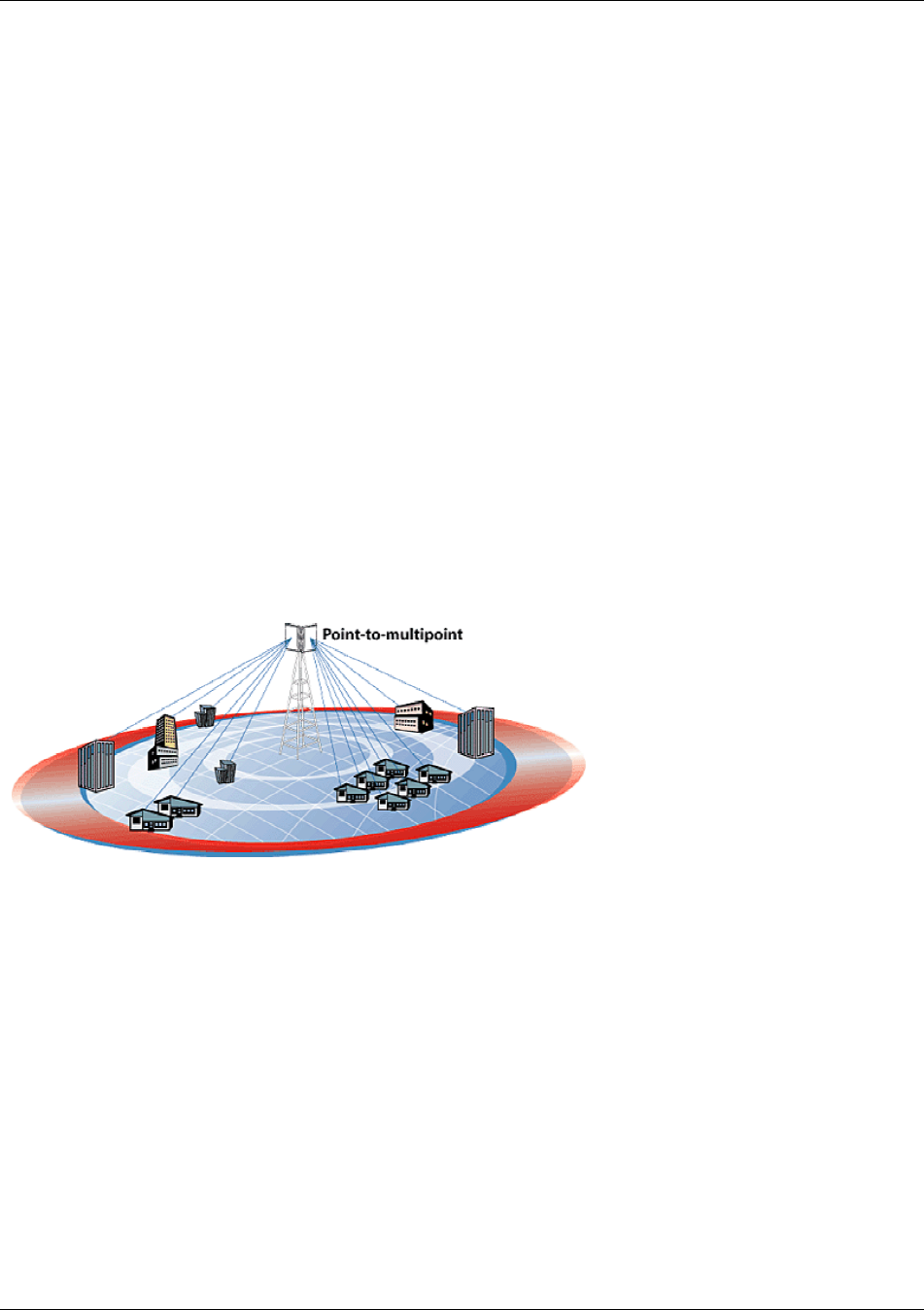
Introduction
Trango Broadband Wireless — User Manual M915S Rev. 1 Page 1
Section 1 Introduction
Your Trango Broadband M915S radio system provides a reliable and robust means to deliver broadband access to a
wide geographic region through wireless Ethernet connectivity. This section will familiarize you with basic
operational concepts, as well as an overview of the various components and hardware of the M915S system.
Overview
The M915S is a highly versatile and cost effective outdoor point-to-multipoint solution for wireless broadband
service providers’ enterprise connectivity applications. The M915S delivers 3 Mbps over the air, and operates in the
900 MHz license free ISM band. Each radio includes an integrated dual polarized (horizontal and vertical) antenna,
as well as a connector for the attachment of an external antenna, such as a Yagi or an omni style antenna. Note: If
you are going to install an external antenna, refer to the M915S Professional Installation Guide. Contact
Technical Support for access to the Professional Installation Guide.
The M915S system consists of two types of radios: Access Points (APs) and Subscriber Units (SUs). Up to 126
subscriber units can be supported by a single AP, which acts as a hub in a star configuration. The AP delivers
wireless broadband service (Ethernet connectivity) to one or more SUs according to a proprietary adaptive dynamic
polling algorithm called SMARTPolling™. The M915S radio units are backward compatible with M900S radios
such that an M915S-AP may be used with M900S-SUs and M915S-SUs may be used with M900S-APs. The main
difference in the design is a better front/back ratio on the internal patch antenna to improve co-location at tower
sites, a redesigned digital section on the printed circuit board, and a new package for the M915S-SU. Network
operators can co-locate multiple APs at a single cell site, thus increasing the aggregate throughput available at each
wireless point of presence (POP).
Figure 1: Typical Deployment
The AP typically resides at the center of the point-to-multipoint (PMP) network. It performs all management
functions, including the allocation of bandwidth for all associated SUs. The M915S AP provides a host of
comprehensive tools and functions.
The M915S system is classified as a Layer 2 multi-point bridge, thus all forms of Ethernet traffic will pass
seamlessly over the system. There is no limitation on the number of IP addresses or hardware devices to which an
individual subscriber unit may be connected.
Authentication of Subscriber Units is performed using a secure proprietary method, which is based on the MAC
address of the subscriber units. In order to establish a wireless link, the MAC address of the SU must be present in
the Access Point’s SUDB.
Both APs and SUs are IP addressable and can be managed remotely across the network. Users can manage the
radios using the telnet command line interface or the graphical HTTP browser interface. The M915S also provides
remote firmware upgrade capability utilizing TFTP. APs include a full-featured SNMP agent for the monitoring
and controlling of both APs and SUs via SNMP.

Introduction
Trango Broadband Wireless — User Manual M915S Rev. 1 Page 2
The M915S radios are powered using "power-over-Ethernet" for ease and low-cost installation. A single Cat-5
cable caries both Ethernet and DC power to the radio.
Both APs and SUs feature a handy "site survey" tool to check for interference, as well as RSSI tools for optimizing
antenna positioning. The M915S also features variable receiver threshold, full power control, dual polarized
antennas, and various link diagnostic tools.
SmartPolling™ & Bandwidth Throttling
One of the major advantages of the M915S system is the ability of the AP to handle multiple SU
connections and share the 3 Mbps data throughput efficiently. Bandwidth allocation is managed by the
AP’s SMARTPolling algorithm according to provisioning rules set up by the system administrator. The
AP polls each SU in a round robin format to determine if the SU has data to transfer. The SU only
transmits the data “upstream” to the AP when the AP gives authorization via a “transmit grant.” The SU
passes every “downstream” data packet from the AP and identifies packets intended for it. In order for an
SU to communicate with an AP, the system administrator must first add the MAC address and ID number
of the SU to the SUDB in the AP. The SmartPolling algorithm will poll active SUs more often, thus
making the most efficient use of the 3 Mbps bandwidth. Several other parameters are considered in the
SmartPolling algorithm including upstream/downstream committed information rate (CIR),
upstream/downstream maximum information rate (MIR), and Priority Setting.
Each of the above parameters is set in the AP by the system administrator and cannot be controlled at the
SU. These parameters will be covered in greater detail later in this text.
When power is first applied to a properly installed SU, it will scan all available channels listening for a
grant from an AP that has a matching Base ID and the SU’s MAC in the its SUDB. The SU will then stop
on that channel and respond to the AP using maximum RF power. Before the AP can add the SU to the
polling list, it must authenticate the SU by verifying the MAC address and performing a ranging operation
to the SU. Upon successfully locating and ranging the SU, the AP will then add the SU to the normal
polling list. Once the AP is regularly polling the SU, the SU is said to be “associated” to the AP.
Once associated, the AP will send a command to the SU to adjust the SU’s RF transmit power based on the Target
RSSI parameter set in the AP. This process is referred to as “power leveling”.
System operators may limit allowable bandwidth to specific customers utilizing the built-in CIR and MIR settings
(measured in kbps) for each SU.
Auto-retransmit Feature (ARQ)
The M915S features ARQ or “Automatic Request for Re-transmission,” which is the ability to correct for missing
or corrupted packets of data by requesting the sending radio to re-transmit the data. Both the AP and SU units
implement a form of ARQ known as “ARQ with Selected Repeat.” The use of ARQ is especially important in
areas of high interference. The ARQ feature can be turned on or off.
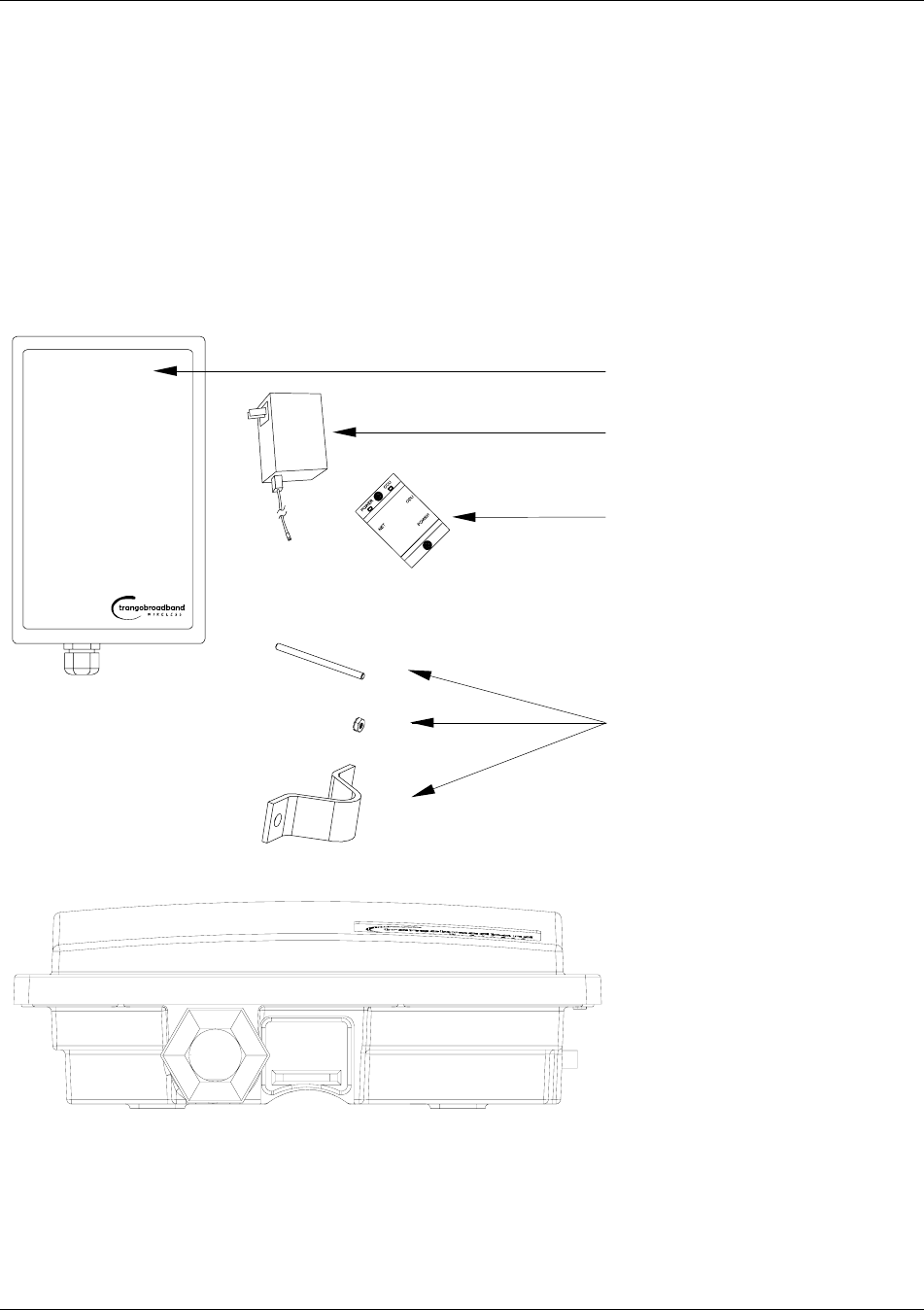
Hardware Overview
Trango Broadband Wireless — User Manual M915S Rev. 1 Page 3
Section 2 Hardware Overview
This section provides details about each radio in the M915S family. The M915S-SU and M915S-AP include built-
in, electronically switchable, dual-polarized antennas, as well as a reverse polarity SMA connector for the
attachment of an external antenna. Both units are designed for outdoor installation, and are powered by power-
over-Ethernet (POE) for ease of installation. The M915S Access Point, as well as the M915S subscriber units,
provide channels of operation within the 900 MHz ISM band that spans from 902 MHz to 928 MHz. The channel
width is 6 MHz, and the default channel assignments allow for 4 non-overlapping channels.
M915S AP and SU Hardware Components
Each radio comes equipped with a power-over-Ethernet (PoE) J-Box, an AC adapter, and mounting hardware.
Radio (MU or RU) antenna
Power Supply (120 VAC-24 VDC)
J-Box (Power-over-Ethernet Injector)
Mounting Hardware
4X
8X
2X
Figure 2: Basic Components of an M915S Radio
Figure 3: Bottom of Radio
At the bottom of the M915S are two access ports: a twist-on weatherproof cable port for RJ-45 Ethernet (and PoE),
and a translucent access cover plug over the unit’s diagnostic LEDs and reset button. The LEDs will be discussed
later in this text.
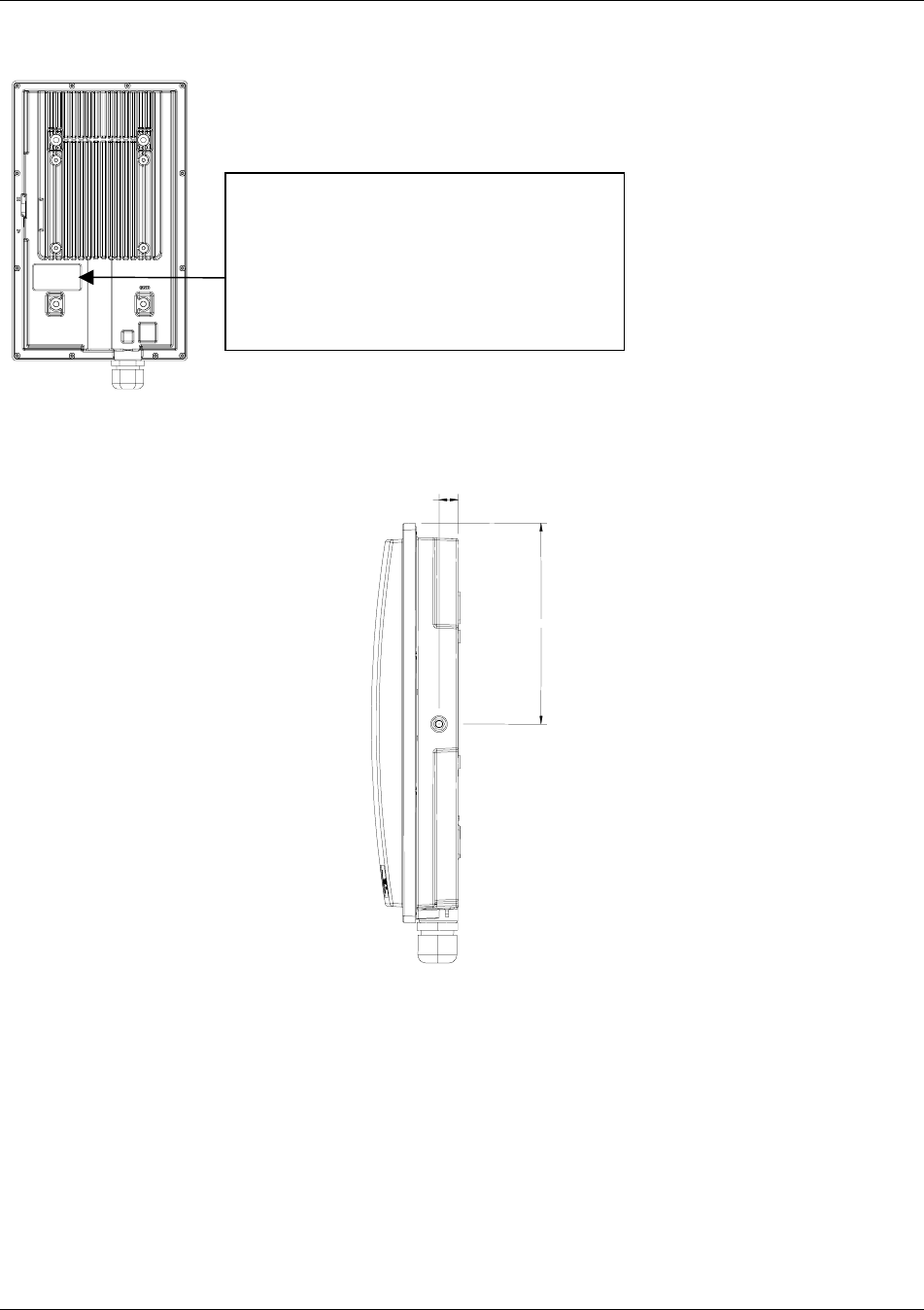
Getting Started
Trango Broadband Wireless — User Manual M915S Rev. 1 Page 4
Figure 4: Back of Radio
The radio’s model number, FCC ID, MAC ID, and Serial number, are located on the backside of the radio.
6.300
.600
Figure 5: Side of Radio & Location of Reverse Polarity SMA Connector
Section 3 Getting Started
This section explains how to power your radios, establish TCP/IP connectivity to the radios, as well as how to
access the HTTP browser and the command line interfaces.
Connections and Power
Connections and powering of the radios is the same for APs and SUs.
• Connect a Cat-5 (straight through) Ethernet cable (we recommend shielded twisted pair) between the ODU
(out door unit) port of the J-box and the RJ-45 connector on the radio. Note that this cable will carry
power-over-Ethernet (PoE).
Trango Broadband Wireless
MODEL: M915S-AP Rev. A
ACCESS900 (TM)
S/N: 00000XXXX
MAC: 00 01 DE 00 02 F3
FCC ID: NCYM915S
CANADA: 2945A-M915S
THIS DEVICE COMPLIES WITH PART 15 OF THE FCC RULES: OPERATION IS
SUBJECT TO THE FOLLOWING CONDITIONS: 1) THIS DEVICE MAY NOT CAUSE
HARMFUL INTERFERENCE, AND 2) THIS DEVICE MUST ACCEPT ANY
INTERFERENCE THAT MAY CAUSE UNDESIRED OPERATION
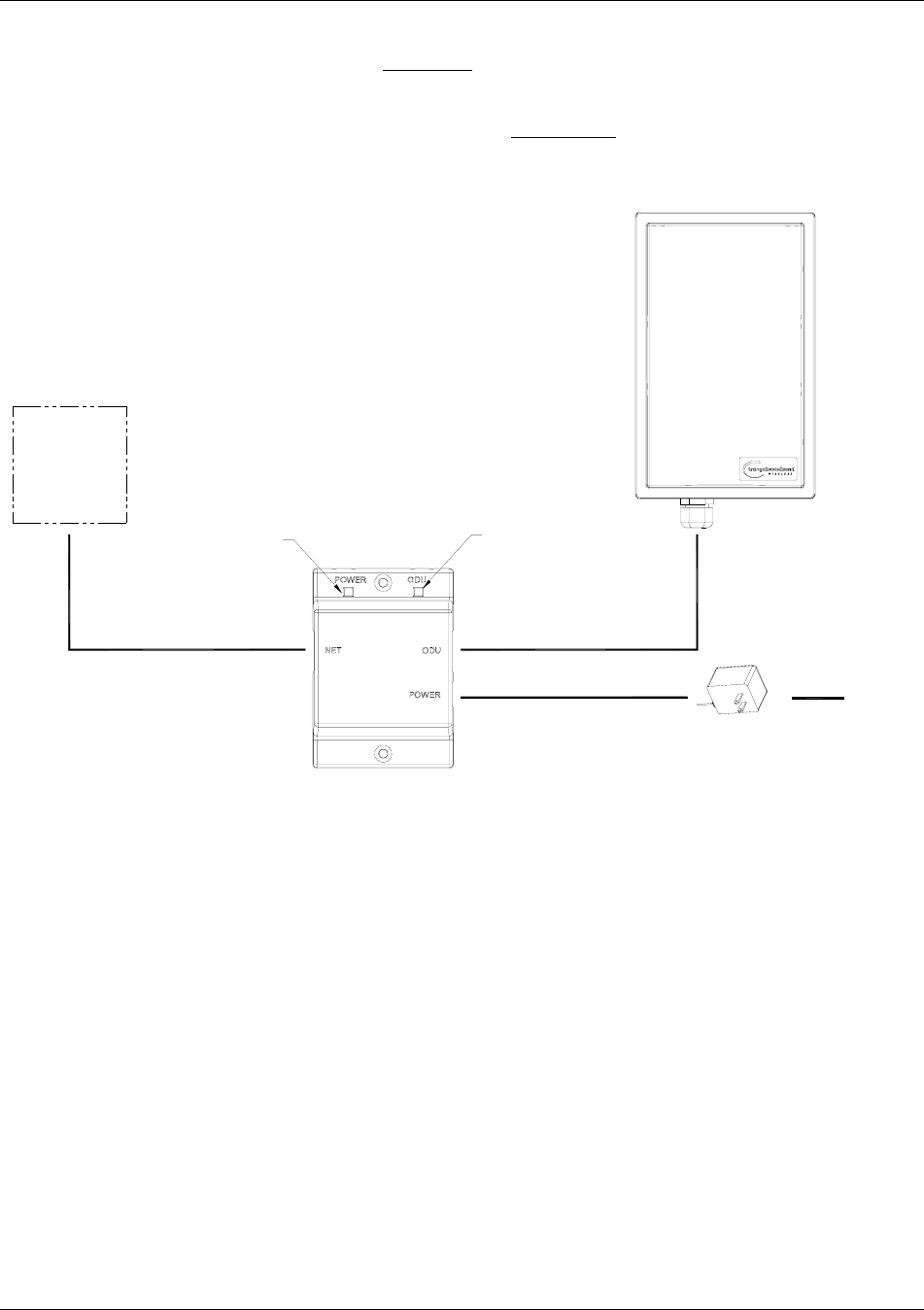
Getting Started
Trango Broadband Wireless — User Manual M915S Rev. 1 Page 5
• If connecting to a COMPUTER, use a Cross-Over Ethernet cable from the NET port of the J-box to the
computer’s Ethernet port.
If connecting to a HUB, SWITCH, or ROUTER, use a Straight-Thru cable.
• Plug the AC adapter into an AC outlet.
CAT-5
STRAIGHT-THRU CABLE
24 VOLT POWER
SUPPLY
AC POWER
M900S (AP o
r
SU)
POWER-OVER-ETHERNET
J-BOX
INDICATES POWER TO RADIO
INDICATES POWER TO J-BOX
NETWORK
OR
COMPUTER
USE STRAIGHT-THRU CABLE
USE CROSS-OVER CABLE IF TO COMPUTER
IF TO HUB, SWITCH, OR ROUTER
CAT-5
Figure 6: Wiring Diagram
Both green LEDs on the J-box should be lit, indicating power is present at the J-box as well as the radio.
You are now ready to configure the radio via the Ethernet port.
Radio Management Concepts
Proper connections to the radios and careful IP/routing & planning will enable the network administrator to access
and manage the radios via TCP/IP remotely over the network. Radio management over TCP/IP can be performed
from computers connected to the Ethernet side of each radio. Computers connected to the AP can manage the SU
over the wireless connection. Computers connected to the SU can manage the AP, provided that switch 7 (TCP/IP
for SU) is enabled on the AP. Switches will be covered later in this text.
Opmode
To fully understand radio management of the M915S system, it is important to be familiar with the concept of
operation mode or “Opmode.”
APs and SUs can be in one of two Opmodes (“ON” or “OFF”). When in Opmode “OFF,” the AP is not
transmitting and it is not attempting to associate with SUs. Alternatively, when in Opmode “ON,” the radio is
transmitting and is attempting to associate.

Getting Started
Trango Broadband Wireless — User Manual M915S Rev. 1 Page 6
Several functions, such as the site survey function and the SU RSSI function, can only be performed while the radio
is in a particular Opmode. See Appendix A – Command Set Reference for a complete listing of commands, and the
appropriate Opmode(s) for each command.
Switch Settings
M915S firmware includes several “switches” that are used to set certain operational parameters of the radios.
Switch settings can be changed via the HTTP browser interface or the command line interface. For purposes of
radio TCP/IP management, the following four switches are important:
Switch 2 (SU) - TCP/IP access to SU from the AP’s side of the network requires that the SU’s switch 2 (SW 2 –
TCP/IP for AP) be ON. Default setting for SW 2 (from factory) is ON.
Switch 5 (AP and SU) – In order to utilize the radio’s HTTP Browser interface, switch 5 (SW 5 – Enable HTTP)
must be ON. Default setting for SW 5 (from factory) is ON.
Switch 6 (SU) - TCP/IP access from Ethernet port of SU requires that switch 6 (SW 6 – TCP/IP Service for
Ethernet Port ) be ON. Default setting for SW 6 (from factory) is ON. If SW 6 is OFF, TCP/IP access to SU
from it’s Ethernet port is possible only if the SU’s Opmode is “OFF.”
Switch 7 (AP) – TCP/IP access to AP from SU’s side of network requires that the AP’s switch 7 (SW 7 –
TCP/IP for SU) be ON. Default setting for SW 7 (from factory) is ON.
Passwords
In order to login to an M915S radio (either through telnet or through the web browser interface), the user must
know the IP address and password. Both APs and SUs feature two levels of passwords, Read Write (RW) and
Read Only (RO). Be sure to change both passwords (RW and RO) prior to deployment on a live network.
Passwords can be changed using the “password ro and password rw command in either the CLI interface or in the
command console of the browser interface.
Reset Button
Pressing the reset button will reset the radio’s IP address and password back to the factory defaults.
Default IP (192.168.100.100) Default Password (trango)
Browser Interface
The M915S (both AP and SU) features a convenient and easy-to-use web based configuration and management
tool. No additional software is needed on your computer other than a web browser. Most functions can be
performed using the browser interface, although several functions can only be performed via command line
interface (CLI). The browser interface also includes a Command Console page that allows the user to enter most
CLI commands without leaving the browser interface.
To use the browser interface, the following must be present:
• An Ethernet connection between a PC and the radio
• Ethernet PC connection with IP/subnet that is routable to the radio
• SW 5 ON (default)
• A web browser on the PC (i.e. Microsoft Internet Explorer)
In order to use the browser interface – simply connect the radio to a PC and type the radio’s IP address (default IP
address=192.168.100.100) into the web browser (i.e. Microsoft Internet Explorer). This will bring up the Login
page.
NOTE: Login pages for the AP and SU are similar.
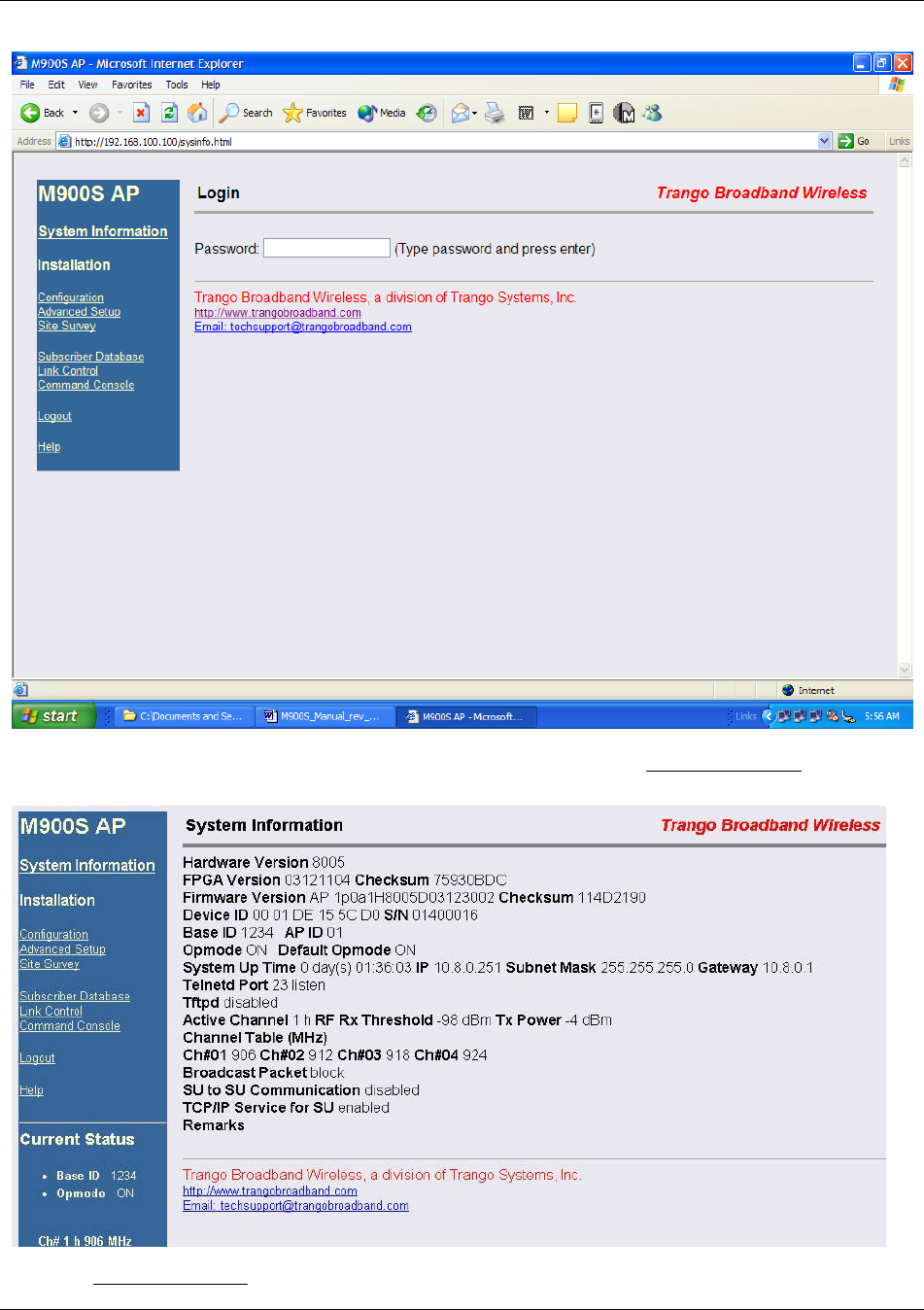
Getting Started
Trango Broadband Wireless — User Manual M915S Rev. 1 Page 7
Browser Interface Login Page
Type the password (default trango) and continue. This will bring up the radio’s System Information page.
Web Browser System Information Page
Note: System Information page for the SU is similar and is covered in detail later in this text.

Getting Started
Trango Broadband Wireless — User Manual M915S Rev. 1 Page 8
Primary Features and Pages of the Browser Interface:
Navigation Column: Each page features a navigation column that runs along the left-hand side of the page. The
model number of the radio is listed at the top of the navigation column. On the bottom of the navigation column is
the current status of the radio including its Base ID, current Opmode, channel, antenna selection, and frequency.
The navigation column also features links to each of the following pages:
System Information: This page shows most of the basic configuration parameters of the radio. It is the first page
shown after login.
Configuration: The essential parameters, such as Base ID, IP, Subnet, gateway, channel, and antenna polarization,
are set here.
Advanced Setup: The advanced RF parameters, such as transmit power, receiver threshold control, and channel
center frequencies, are set here.
Site Survey: With Opmode “Off” the user can conduct a spectrum analysis using this page.
Subscriber Database: This is the page for defining which SUs can associate to the AP.
Link Control: This page shows which SUs are associated. This page also provides several tools for evaluating the
quality of the wireless link.
Command Console: From this page, the user can run any console command that is not interactive (i.e. ipconfig)
or time sensitive (su linktest). For a complete list of console commands, type "help" or “?” in the entry field.
Logout: This link will end the current browser session with the radio.
Help: The Browser Interface features useful Help pages that explain all listed parameters. To access the Help
pages click on the Help link.
Command Line Interface
Although most radio functions can be managed via the browser interface, the command line interface (CLI)
provides slightly more functionality, and is usually the management tool of choice for experienced users. The CLI
can be accessed through Telnet.
Telnet
Open a command prompt (DOS) session on your PC. Open a Telnet session by typing:
telnet [ip address of radio]
All Trango radios are pre-configured at the factory with a default IP address of 192.168.100.100. The factory
default password is trango. Once you connect to the radio you will be greeted with the current hardware and
firmware information and prompted for a password. Type in the read-write (RW) password and press enter.
Example:
C:>telnet 192.168.100.100
Welcome to Trango Broadband Wireless M915S-AP 1p0H8005D04030101
Password:
#>
To terminate a CLI session (Telnet or Serial) type the command logout.
Note: Type help or ? for a listing of all the CLI commands. Type help <command>, for the syntax of a
particular command.

Getting Started
Trango Broadband Wireless — User Manual M915S Rev. 1 Page 9
Example (to view a list of all commands which start with su)
#> ? su
su [all | <suid, 1..126>]
su info <suid, 1..126>
su linktest <suid, 1..126>
su password <suid|all> <rw|ro> <new password> <new password>
su ping <suid, 1..126>
su reboot <suid|all>
su sw <suid|all> <sw#, 0..7> <on | off>
su testrflink <suid, 1..126> <r>
su testrflink <all> <r>
sudb add <suid, 1..126> <pr|re> <device id,hex>
sudb cirmir <<suid>|all> <cir dn> <cir up> <mir dn> <mir up>
sudb defaultcirmir [<cir dn> <cir up> <mir dn> <mir up>]
sudb delete <<suid>|all>
sudb dload
sudb gid <<suid>|all> <0..15>
sudb view
survey <time, 1..10 sec> <antenna, h|v|e>
NOTE: The majority of the CLI commands will be covered throughout this text as well as in Appendix A −
Command Set Reference.
Troubleshooting
If you can not telnet into the radio or open a browser session, check cable connections, ensure proper use of cross-
over vs. straight-through cable, and ensure PC’s subnet is routable to radio’s IP address. If you still cannot access
the radio’s management interfaces, consult the troubleshooting guide that is available at
www.trangobroadband.com in the Technical Support area of the website.

Basic Configuration via Browser Interface
Trango Broadband Wireless — User Manual M915S Rev. 1 Page 10
Section 4 Basic Configuration via Browser Interface
This section describes a few more basic concepts, as well as how to establish a wireless link using the Browser
(HTTP) Interface. This section is written to address only the most basic steps in establishing a link in the lab or a
bench-top environment. It is highly recommended that you read the other sections of this manual to gain an
understanding of all important configuration parameters and procedures prior to deploying your equipment.
In this section you will:
• Learn about AP and SU Basic Configuration Screens and Parameters
• Populate the AP’s Subscriber Unit Data Base (SUDB) with at least one SU
• Configure Other Basic AP Parameters
• Configure Basic SU Parameters
• Establish a Wireless Link
• Evaluate Link Quality
The M915S uses the concept of “association” to indicate that the APs and SUs are communicating. If all
parameters are properly set, the AP will begin actively searching for the SUs in its SUDB. Once an active SU is
detected, the authentication and association process will begin.
Essentials for Establishing a Wireless Link with M915S Series Radios
• Base ID in AP and SU must match
• MAC Address of SU must match an entry in the SUDB
• SU must be set to “autoscan” all channels, or it’s channel must be fixed on the same channel as the AP
• AP must be in Opmode “ON”
• SU must be in Opmode “ON”
• Adequate signal strength must be received at each radio
If all of these parameters are met, the wireless link will automatically establish itself and Ethernet traffic will begin
to pass between the radios.
Note: This section utilizes the Browser Interface as the configuration tool. For the equivalent procedure using
CLI commands, see Section 5.
Configuring the AP’s Subscriber Unit Database (SUDB)
Prior to establishing a wireless link, the user must configure the SUDB in the AP with each SU’s MAC address and
related settings. The SUDB includes information about each SU. Click on the Subscriber Database page to add,
modify, and delete SUs. The key information for each SU includes the following:
SU ID: User Definable subscriber unit ID (1…126)
TYPE: PR Priority or REG Regular. Priority SUs are polled much more frequently than regular SUs.
Priority SUs in general will respond to the AP with less latency than regular SUs.
Group: SU to SU Group # (1..F in hex) for SU to SU communications within the same sector. Note:
This SU to SU feature allows interconnectivity between multiple SU’s in the same sector,
without the need for a router. Only SUs with the same SU to SU group # may communicate
with each another. If you do not want the SUs to communicate with each other, choose N/A
for SU to SU group. In order to use SU to SU communication, AP switch #3 must be ON.
The default setting for switch #3 is OFF.
CIR UP: Committed Information Rate from SU to AP. Minimum upstream data rate (measured in
Kbps) at which the SU will attempt to deliver bandwidth to the AP. Maximum setting is
3000.
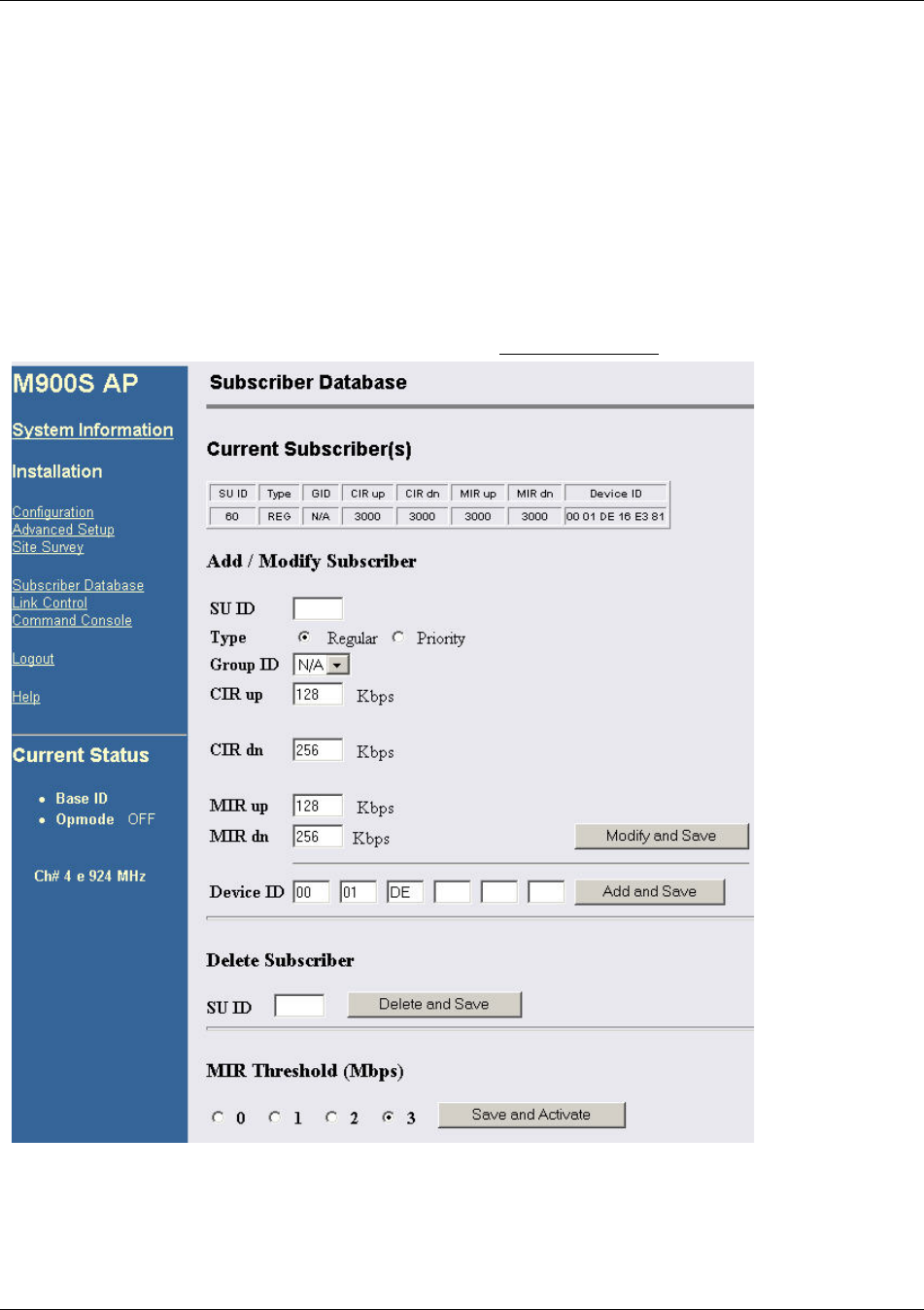
Basic Configuration via Browser Interface
Trango Broadband Wireless — User Manual M915S Rev. 1 Page 11
CIR DOWN: Committed Information Rate from AP to SU. Minimum downstream data rate (measured in
Kbps) at which the AP will attempt to deliver bandwidth to this SU. Maximum setting is
3000.
MIR UP: Maximum Information Rate from SU to AP. Maximum upstream data rate (measured in
Kbps) at which the SU will attempt to deliver bandwidth to the AP. Maximum setting is
3000.
MIR UP: Maximum Information Rate from AP to SU. Maximum data rate (measured in Kbps) at
which the AP will attempt to deliver bandwidth to this SU. Maximum setting is 3000.
DEVICE ID: MAC address of the SU.
Creating an SU in the SU Database.
1. Connect to the AP (see Getting Started) and open the Subscriber Database page.
2. Enter SU ID (range 1 – 126).
3. Select either PRIORITY or REGULAR.
4. If SU will be part of an SU to SU group, enter the SU to SU group number.
5. CIR up: (SU to AP Committed Information Rate) – minimum upstream bandwidth for the SU in Kbps.

Basic Configuration via Browser Interface
Trango Broadband Wireless — User Manual M915S Rev. 1 Page 12
6. CIR dn: (AP to SU Committed Information Rate) – minimum downstream bandwidth for the SU in Kbps.
7. MIR up: (SU to AP Maximum Information Rate) – maximum upstream bandwidth for the SU in Kbps.
8. MIR dn: (AP to SU Maximum Information Rate) – maximum downstream bandwidth for the SU in Kbps.
9. Enter Device ID (MAC Address of the SU).
10. Save and Activate changes.
!
Important! Always remember to Save and Activate changes, or the SUDB will revert back to its previous
state after a power cycle or reboot.
!
Important! SUs using SU to SU communication must be on the same subnet.
Configure Other Basic AP Parameters
In addition to setting up the SU in the SUDB, the following settings in the AP’s Configuration page must be set (or
left at default).
Base ID: Four character, alphanumeric, user definable base station ID. Input of BASEID shall be in the
format of xxxx. Where x is any character from the set: {0..9; a..z; A..Z; '!@#$%^&*()_+[]\<>,./?'}.
The Base ID is typically assigned to a single AP or a group of APs at a particular cell site. The
Base ID in the AP must match the Base ID in the SU in order for a link to be established. This
parameter can only be changed while in Opmode "OFF."
AP ID: User definable AP ID (00-FF). Default is last two digits of MAC ID. One authenticated, the AP
will automatically assign its AP ID to the SU. This parameter can only be changed while opmode
is “OFF”.
IP Address, Subnet Mask, Gateway:
The IP configuration of the radio. Used for configuration and network management purposes.
Since this is a layer-II device, these parameters do not play a role in the establishment of the
wireless link.
Default Opmode:
Operation mode of the radio after a power cycle or reboot. When the radio enters Opmode "ON," it
will be transmitting. When the radio enters Opmode "OFF," the radio will not be transmitting, but
can be accessed through the Ethernet port. The radio can be put into Opmode "OFF" regardless of
its default Opmode by telnetting into the radio within the first 30 seconds after a power cycle or
reboot.
Active Channel/Polarization:
The current channel and antenna polarization of the unit when in Opmode "ON."
To configure the AP’s other basic settings, complete the following steps:
1. Connect to the AP (see Getting Started) and open the Configuration page.
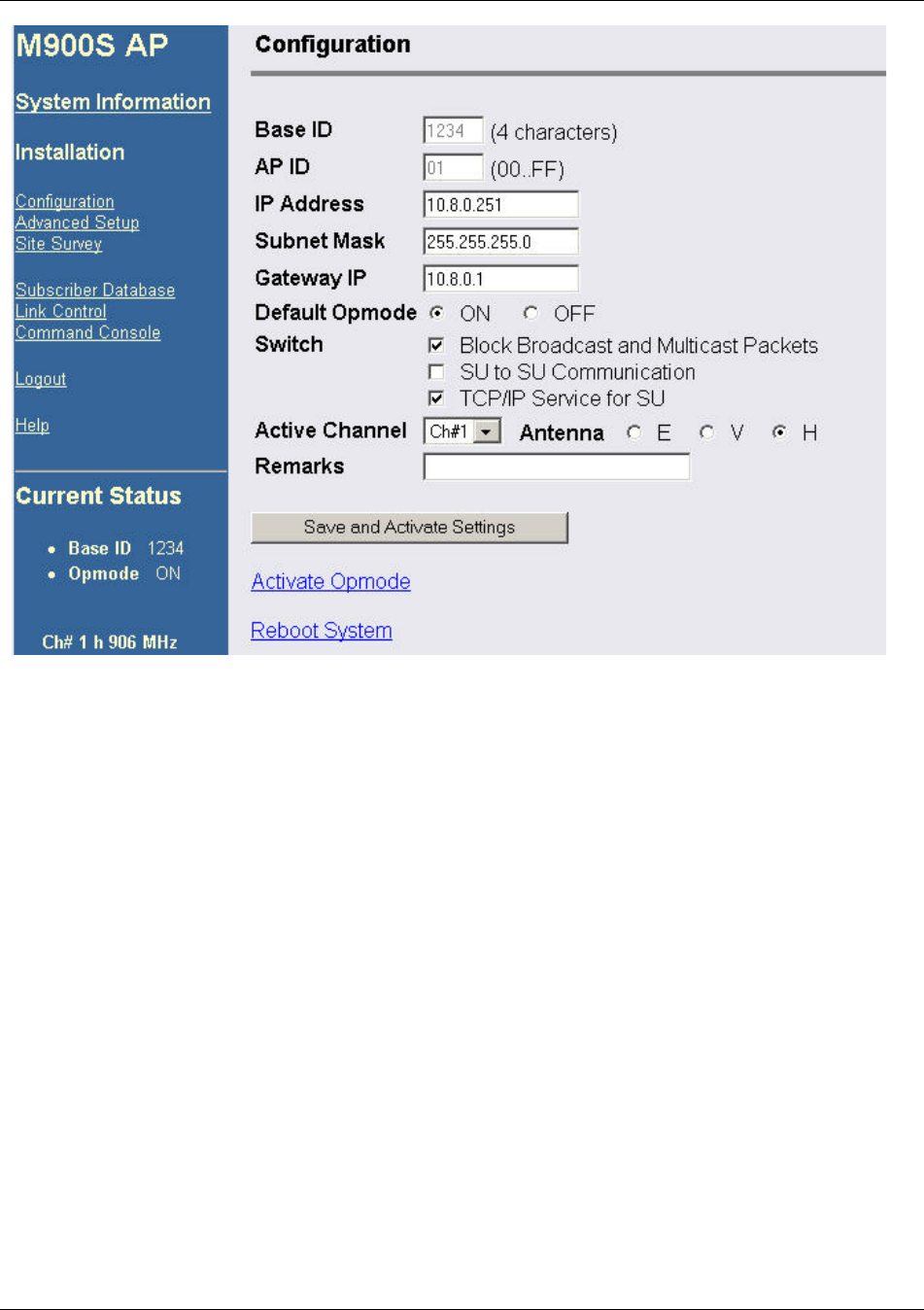
Basic Configuration via Browser Interface
Trango Broadband Wireless — User Manual M915S Rev. 1 Page 13
2. Set Base ID, or choose the default Base ID of 0000. (Must match the SU.)
3. Set AP ID (00-FF HEX), or choose the default, which is last two bytes of MAC Address.
4. Set IP, Subnet, and Gateway, or leave at default settings. Keep in mind, if you change the IP Settings of
the radio, you will loose your HTTP session when you Save and Activate Settings.
5. Choose Active Channel (1-4).
6. Choose Antenna Polarization (H or V), or choose E for an external antenna. Only use E for M915S-SU-
EXT model.
7. Ensure default Opmode is "ON."
8. Save and Activate Settings.
9. If this is the first SU to be added to the SUDB, reboot the AP.
After reboot, the AP will automatically enter its default Opmode (ON) after approximately 40 seconds. At this time
it will begin actively searching for all SUs in its SUDB. Once an active SU is detected, the authentication and
association process will begin.
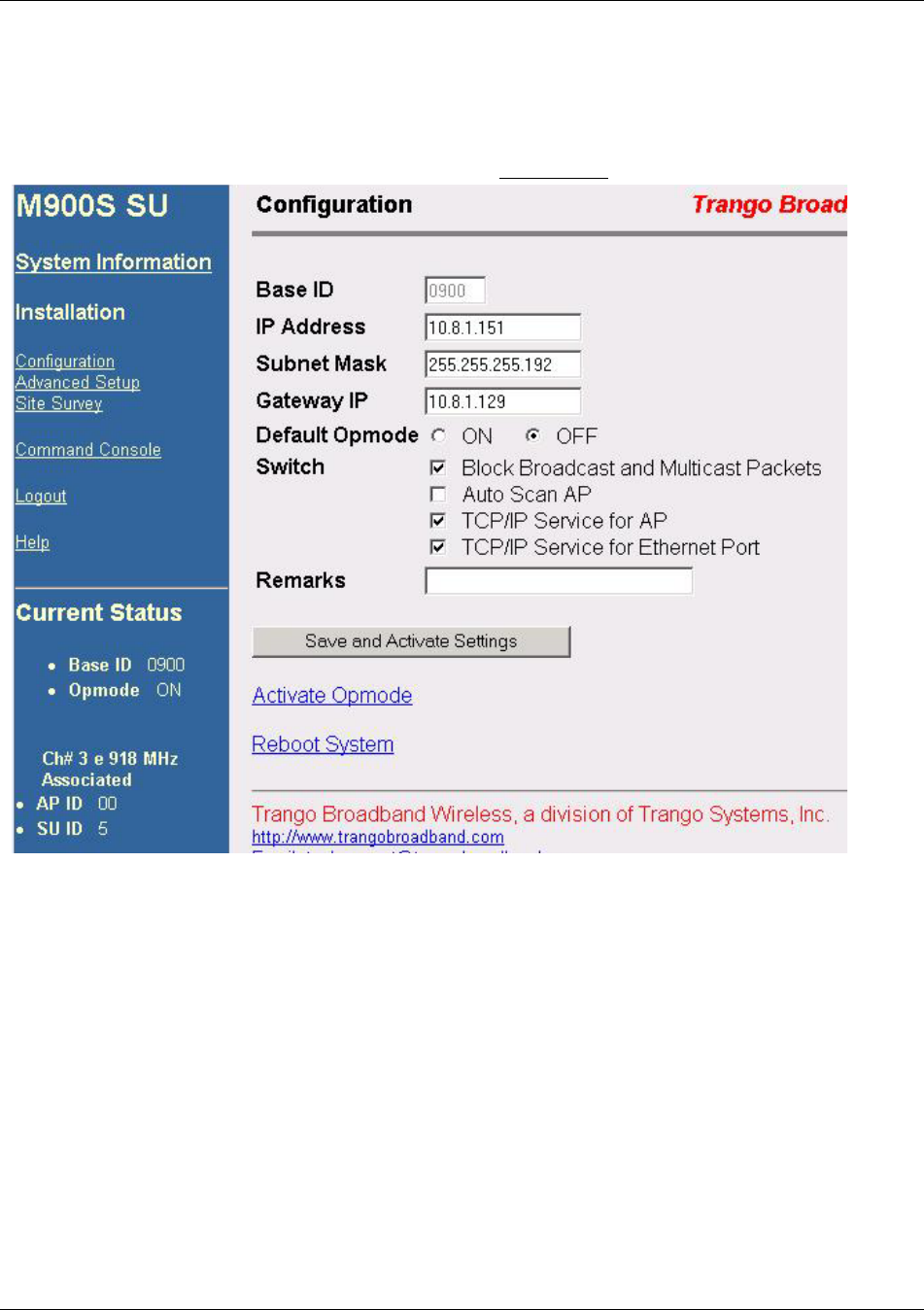
Basic Configuration via Browser Interface
Trango Broadband Wireless — User Manual M915S Rev. 1 Page 14
Configure Basic SU Parameters
In order to establish a working link, the Base ID in the SU must match the Base ID set in the AP.
SU Basic Setup:
1. Connect to the SU (see Getting Started) and open the Configuration page.
2. Set Base ID. (Must match the AP.)
3. Set IP, Subnet, and Gateway, or leave at default settings. Keep in mind, if you change the IP Settings of
the radio, you will loose your HTTP session when you Save and Activate Settings.
4. Ensure default Opmode is "ON."
5. Save and Activate Settings.
6. If in Opmode “OFF,” click Activate Opmode.
At this point, if all parameters have been set correctly and the radios are within range, a wireless link between the
AP and SU will automatically become established. Once this occurs the SU will be in “associated” status.
Allow approximately 60 seconds for the radios to complete the boot-up cycle and to associate. If the
AP is busy servicing many SUs, the association process may take slightly longer.
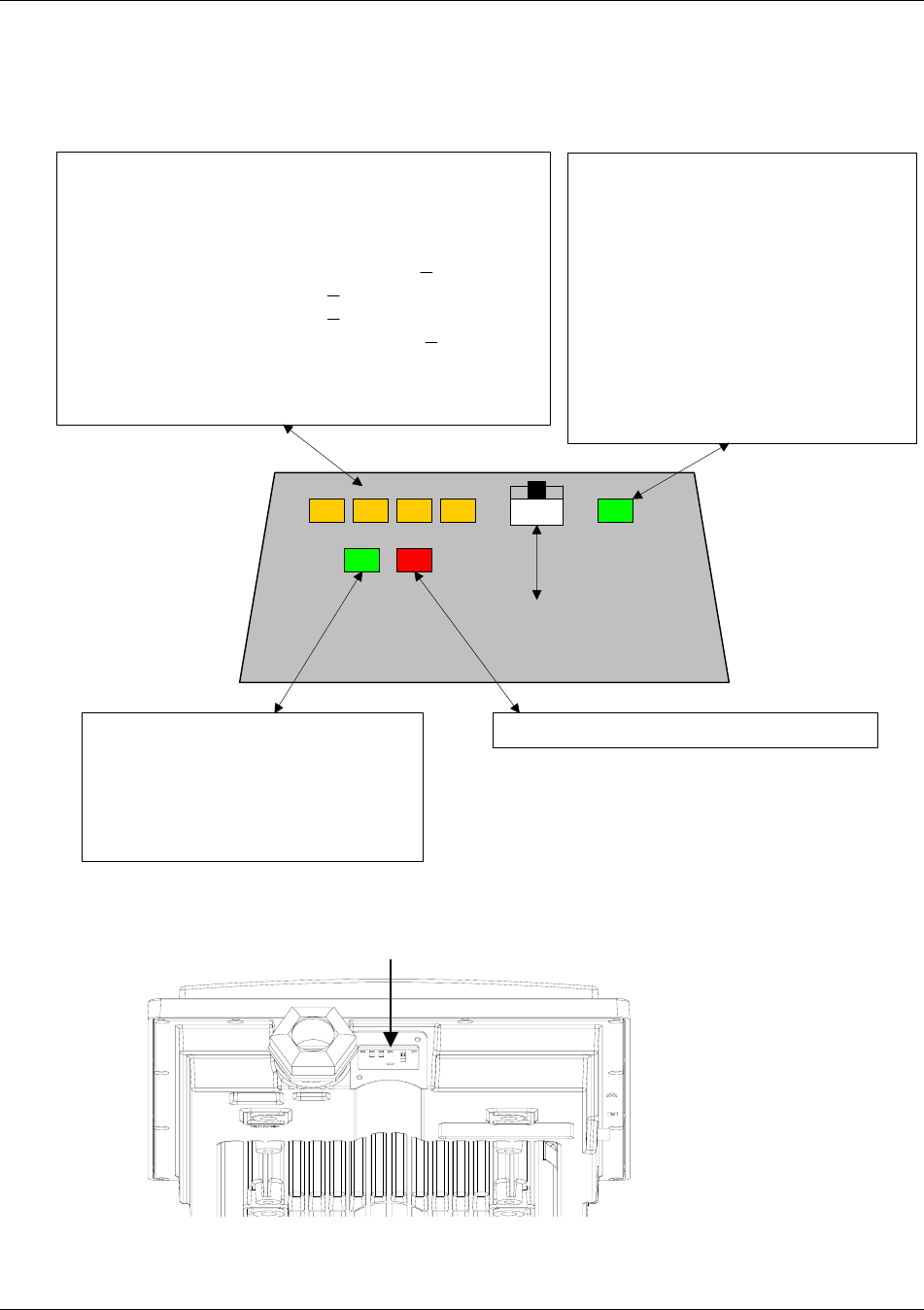
Basic Configuration via Browser Interface
Trango Broadband Wireless — User Manual M915S Rev. 1 Page 15
LED Summary
At this point it is useful to learn about the LEDs that can be found on the bottom of the radio. These LEDs can
assist the user in determining radio and link status.
ASSOCIATION LED (GREEN)
Blinking once every second in
Opmode "OFF" (AP and SU).
Twice per second Opmode "ON" and
scanning for an AP (SU Only).
Solid after unit is associated with an
AP (SU Only).
Solid after unit is in Opmode "ON" (AP
Only).
ACT LED (RED) - Ethernet Activity Light
10/100 Link LED (GREEN) -
Illuminated when link speed is
negotiated at 100 BaseT. It is off
when link speed is 10 BaseT or not
connected.
RSSI LEDs (YELLOW) - In all modes except "Survey,"
the unit's four yellow LEDs indicate the level of RF
signal being received from a valid AP.
Yellow LED 1 (rightmost): On when RSSI > -85 dBm
Yellow LED 2 : On when RSSI > -75 dBm
Yellow LED 3 : On when RSSI > -65 dBm
Yellow LED 4 (leftmmost): On when RSSI > -55 dBm.
In addition, these 4 LEDs will flash once to indicate the
'factory reset' button has been activated.
RESET BUTTON - resets IP and
password to factory default
Figure 7: LED Summary
Figure 8: LED and Reset Button Window
LED / RESET BUTTON WINDOW
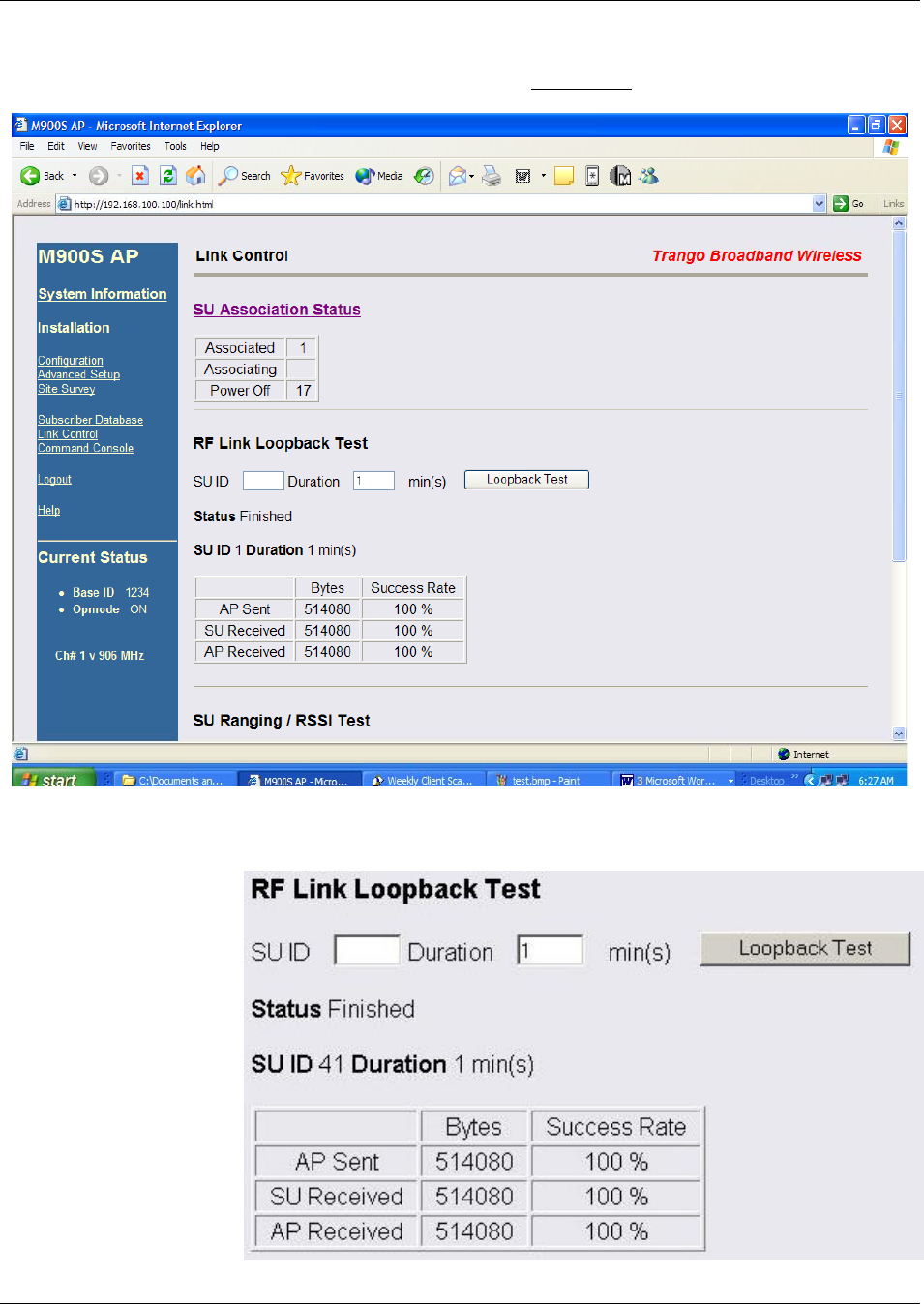
Basic Configuration via Browser Interface
Trango Broadband Wireless — User Manual M915S Rev. 1 Page 16
Link Control Page
The radio’s firmware includes several useful tools to assist in determining which SUs are associated and the quality
of each link. One method for verifying link quality is by using the Link Control page.
On this page the user can immediately see which SUs have associated. In the page shown, SU ID# 1 is associated,
and SU ID 17 is not. Consider "Power Off" status synonymous with "not associated."
RF Link
Loopback Test
The RF Link Loopback test
is one of the built-in tools
for evaluating the quality
of the wireless link.
Specify an SU ID and time
in minutes to conduct the
test. The test is prioritized,
so it will take precedence
over all other traffic. 1600
byte packets are sent and
received between the SU
and AP at 50 millisecond
intervals over the time
specified.
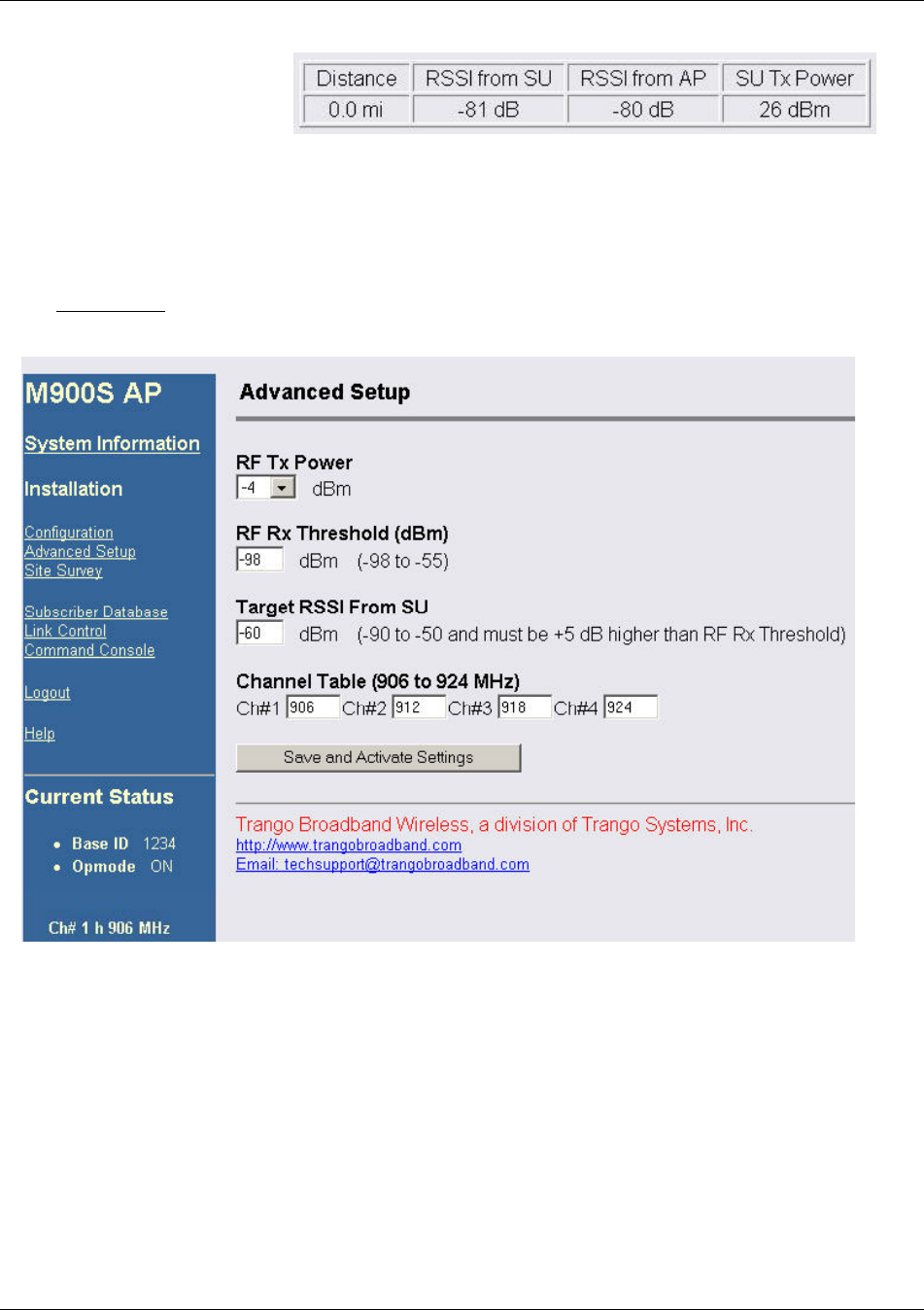
Basic Configuration via Browser Interface
Trango Broadband Wireless — User Manual M915S Rev. 1 Page 17
SU Ranging Test
This test reports the SU’s
distance from the AP in miles,
received signal strength for
uplink and downlink, and SU Tx
Power. Use a link budget calculator to analyze results.
Advanced Setup Page
The Advanced Set up page includes several important parameters including RF TX Power, RF RX Threshold,
Target RSSI from SU (AP only), and Channel Table.
RF TX Power: Sets the conducted RF power output of the radio. Highest allowable setting is 26 dBm.
Lowest setting is –4 dBm. This value does not include antenna gain. A higher number is
more powerful.
RF RX Threshold: Sets the receive threshold of the radio. The radio will not process signals received below
this level, so it is very useful for interference mitigation. For a smaller radius of
operation use a higher threshold (-75 is higher than -80).
Target RSSI from SU: Used by the powerleveling process to automatically adjust the RF output power level of
all SUs in a sector so the signal strength from each SU as measured at the AP will be
roughly equal.
Channel Table: Assigns channel numbers to actual frequencies of operation. Default settings allow the
largest number of channels (4) within the band, while still maintaining 6 MHz channel
spacing.
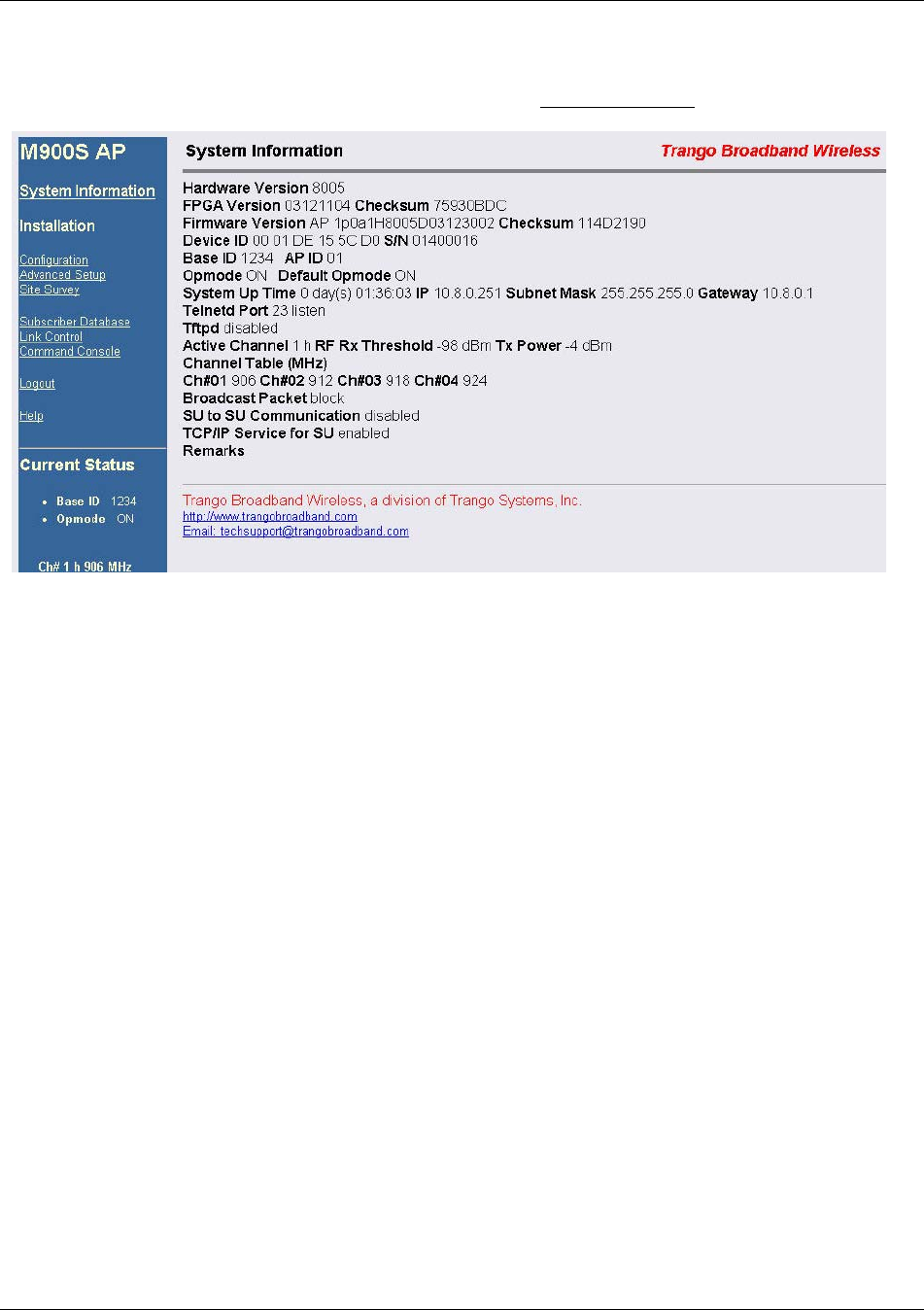
Basic Configuration via Browser Interface
Trango Broadband Wireless — User Manual M915S Rev. 1 Page 18
Other Key Parameters
This section describes the remainder of the parameters listed on the System Information page. Most of these
parameters are the same for both APs and SUs.
Hardware Version: Hardware version is factory-set and cannot be changed by the user.
FPGA Version: Low-level field programmable gate array firmware currently loaded on the radio. Normally the
FPGA firmware will not require upgrading. IMPORTANT: The M915S FPGA load is not the same as the
M900S FPGA. Do not attempt to load the M900S FPGA into the M915S or vice versa.
Firmware Version: Main firmware. In this example, the version part of the string is 0p1 (v0.1) , the hardware
code is H8015, and the remainder of the string is a date code.
Device ID: MAC address of the radio.
S/N: Serial number of the radio.
Telnetd Port: User changeable telnet port of radio.
TFTPd: Current status of TFTP daemon. Used for uploading firmware.
MIR Threshold: Enable/Disable the Maximum Information Rate (MIR) Threshold. The MIR Threshold is the
aggregate throughput on the AP at which the AP will start to enforce CIR rules for SUs.
Active Channel: The channel currently being used by the radio.
RFRX Threshold: Sets the receive threshold of the radio. The radio will not process signals received below this
level, so it is very useful for interference mitigation. For a smaller radius of operation use a higher threshold (-65 is
higher than -70).
Broadcast Packet: This software switch (0) enables/disables the blocking of Ethernet control packets, except
ICMP and ARP, to reduce the amount of unnecessary overhead introduced into the wireless link.
SU to SU Communication: If enabled (via switch 3), SUs with matching SU to SU groups (except group 0) can
communicate in peer-to-peer mode via the AP without the need for a router behind the AP.
TCP/IP Service for SU: If enabled, the AP can be accessed via TCP/IP (Telnet or HTTP) from the SU side of the
network via the wireless link.
Remarks: User definable radio information (i.e. customer name, address of installation, etc). A maximum of 28
characters can be stored.
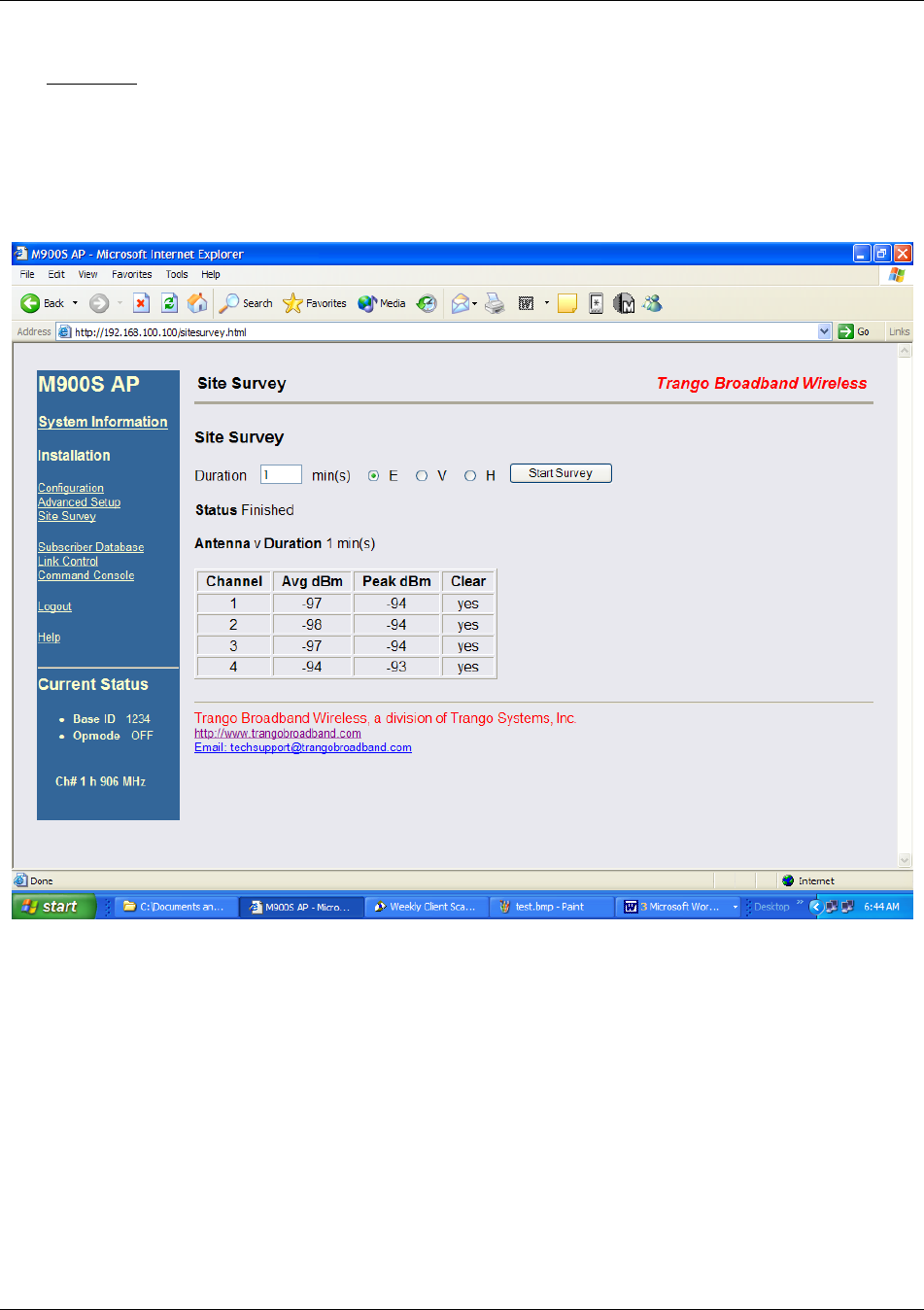
Basic Configuration via Browser Interface
Trango Broadband Wireless — User Manual M915S Rev. 1 Page 19
Site Survey Page
The Site Survey page provides a useful tool for detecting and measuring interference. The radio must be in
Opmode “OFF” in order to use this feature.
Enter the number of minutes desired for the survey, and select the polarization H, V, or E (for an external antenna).
Click "Start Survey." A survey of the default 4 channels will be performed. Results are reported in dBm per
channel as average and peak. A channel is reported to be "Clear" if the peak and average are below the RF RX
Threshold by more than 8 dB.

Basic Configuration via CLI
Trango Broadband Wireless — User Manual M915S Rev C Page 20
Section 5 Basic Configuration via CLI
This section covers how to utilize the radio’s CLI interface to establish a working wireless link.
In this section the most basic settings using the CLI are discussed. Topics include:
• Access Point Basic Settings
• Subscriber Unit Database Settings
• Subscriber Unit Basic Settings
See Appendix A − Command Set Reference for a complete listing of the CLI commands.
See the “Getting Started” section for a description of how to access the radio via Telnet or Serial Interface.
Access Point Basic Settings
After logging into an AP or SU, it is good practice to type the sysinfo command to see the radio’s basic system
information. Example (Access Point):
#> sysinfo
[Hardware Version] 8005
[FPGA Version] 03121104 [Checksum] 75930BDC
[Firmware Version] AP 1p0a2H8005D04010603 [Checksum] AE5D873F
[Device ID] 00 01 DE 15 5C D0 [S/N] 01400016
[Base ID] 1234 [AP ID] 01
[System Up Time] 0 day(s) 00:29:56
[Opmode] on [Default Opmode] on
[IP] 10.8.0.254 [Subnet Mask] 255.255.255.0 [Gateway] 10.8.0.1
[Httpd Port] 80 [Httpd Status] listen
[Telnetd Port] 23 [Telnetd Status] connected (10.8.0.62,1146)
[Tftpd] disabled
[RF Tx Power] -4 dBm
[RF Rx Threshold] -98 dBm
[MIR Threshold] 3 Mbps
[Ch#01] 906 Mhz [Ch#02] 912 Mhz [Ch#03] 918 Mhz [Ch#04] 924 Mhz
[Default Channel] 1 h [Active Channel] 1 h
[Broadcast Packet] block [SU to SU] off [TCP/IP for SU] on
[Remarks]
[RF Rx] 0 kbps [RF Tx] 0 kbps [Eth Rx] 1 kbps [Eth Tx] 0 kbps
Many of these parameters can be changed by the user. A description of each of these changeable parameters, along
with the related command, is shown in the table below.
!
Important! When changing settings, it is usually necessary to type the save ss command in order to update
the radio’s flash memory. If you do not type the save ss command, the setting will be lost the next time the
radio is rebooted or power cycled.
.
AP SYSTEM INFORMATION PARAMETERS AND RELATED COMMANDS
AP Parameter Description Related CLI Command
Device ID MAC Address of AP N/A
Base ID Specifies the cell or cluster to
which the AP belongs. Base ID
must match in AP and SU in
order to establish a wireless
link.
set baseid <baseid>
Example:
#>set baseid aa12

Basic Configuration via CLI
Trango Broadband Wireless — User Manual M915S Rev C Page 21
AP SYSTEM INFORMATION PARAMETERS AND RELATED COMMANDS
AP Parameter Description Related CLI Command
AP ID This parameter provides a
unique number for each AP. If
Target AP is specified on SU,
the SU can only authenticate
with the specified AP. The
default AP ID is the last two
bytes of the MAC address.
set apid <apid> (00-FF in HEX)
Example:
#>set apid 33
Opmode Current Opmode of the radio. opmode on y
This sets the radio to Opmode “ON.” If the radio is
accessed via the Ethernet port within the first 30
seconds after reboot/power cycle, the Opmode will
default to “OFF.”
Default Opmode Determines the Opmode (“ON”
or “OFF”) of the radio after
reboot/power cycle. When this
parameter is set to “ON,” the
radio will progress into
Opmode “ON” automatically
after a reboot/power cycle.
set defaultopmode <on or off>
Example:
#>set defaultopmode on
Opmode Start Determines the amount of time
the radio will remain in
Opmode “OFF” after
reboot/power cycle before
progressing to the default
Opmode.
set defaultopmode on [<time (sec)>]
Example:
#>set defaultopmode on 60
IP
Subnet
Gateway
IP, Subnet, and Gateway
address of the radio.
ipconfig [<new ip> <new subnet mask> <new
gateway>]
Example:
#>ipconfig 10.1.1.2 255.0.0.0 10.1.1.1
TFTPD Status TFTPD status (on or off).
TFTPD should be turned on to
import a file into the radio
(such as new firmware).
Default is off. TFTPD will
revert to Off after rebooting.
tftpd [<on|off>]
Example:
#>tftpd on

Basic Configuration via CLI
Trango Broadband Wireless — User Manual M915S Rev C Page 22
AP SYSTEM INFORMATION PARAMETERS AND RELATED COMMANDS
AP Parameter Description Related CLI Command
MIR Threshold (Kbps) User specified MIR Threshold.
To specify total throughput
level that the AP will serve only
CIR (committed information
rate) to associated SUs.
When MIR Threshold is
disabled, the AP will serve MIR
for all its SUs.
When MIR Threshold is
activated, and the network
traffic exceeds the MIR
Threshold, the AP will only
serve CIR for all its SUs.
When MIR Threshold is
activated, and the network
traffic does NOT exceed the
MIR Threshold, the AP will
still serve MIR for all its SUs.
mirth [<0..3, Mbps>]
Example:
#>mirth 2
Active Channel Current RF channel freq [<ch#>]
Example:
#>freq 3
This command will change the channel of the AP to
3.
Antenna Current antenna selection:
(h)horizontal, (v)vertical,
(e)external
antenna [<v|h|e>]
RF RX Threshold Specifies the receiver
sensitivity of the AP. It is a
powerful tool when the radio is
in a noisy environment. AP
will block out any signal
received which is below the RF
Rx threshold. Separate settings
exist for both ISM and UNII
bands.
rfrxth <-90|-85|-80|-75|-70|-65>
example:
#>rfrxth –70
RF TX Power Current transmit power of the
AP not including antenna gain.
power <set> <min|max|<dBm>
Example:
#>power set 10
Channel Table Assigned frequencies to
channels. All channels may be
re-assigned as desired by the
administrator.
freq writechannel [<ch#> <freq>]
Example:
#>freg writechannel 3 910
This command will change channel 3 to 910 Mhz.
Broadcast Packet Filter This software switch (0)
enables/disables the blocking of
Ethernet control packets, except
ICMP and ARP, to reduce the
amount of unnecessary
overhead introduced to the
wireless link.
sw 0 [<on|off>] (default is on)
Example:
#>sw 0 on
note: All switch settings (0-7) are set using the sw #
[<on/off>] command.
SU to SU This software switch (3)
enables/disables the SU to SU
feature. When SU to SU is
sw 3 [<on|off>] (default is off)
Example:
#>sw 3 on

Basic Configuration via CLI
Trango Broadband Wireless — User Manual M915S Rev C Page 23
AP SYSTEM INFORMATION PARAMETERS AND RELATED COMMANDS
AP Parameter Description Related CLI Command
turned on, multiple SU’s within
the same sector (meaning
associated to that AP) can
communicate with each other,
provided they have the same
SU2SU group number.
TCP/IP for SU This software switch (7) when
on, allows users on the SU side
of the network to telnet or
HTTP into the AP.
sw 7 [<on|off>] (default is on)
Example:
#>sw 7 off
Remarks User definable radio
information (i.e. customer
name, address of installation,
and so on). A maximum of 28
characters can be stored.
remarks [<remarks>]
Example:
#>remarks 123 Elm Street
Subscriber Unit Database (SUDB) Settings
Once you are familiar with the basic system information presented above, you are ready to add one or more SUs to
the SUDB. There are five basic commands related to the SUDB: sudb add, sudb cirmir, sudb defaultcirmir, sudb
view, and save sudb.
Adding an SU
To add an SU to the database, you will need to know the following information:
1. MAC ID of the SU (printed on the back of the SU).
2. Polling priority, either PRIORITY or REGULAR.
Note: SUs designated as PRIORITY will get polled more often by the AP.
To add an SU to the database, use the following command and syntax:
sudb add <suid> <pr|reg> <device id>
suid: SU ID
pr: priority user
reg: regular user
<device id>: xx xx xx xx xx xx in hexadecimal (this is the MAC address of the SU)
Example:
#>sudb add 5 pr F3 3C 50 67 89 D4
In this example an SU #5 was added as a Priority SU . The MAC ID of the SU is F3 3C 50 67 89 D4.
Note: You can add up to 126 entries in the SUDB.
CIR / MIR Commands
The default CIR/MIR setting is 3000 kbps for upstream and downstream.
To change the SU’s CIR/MIR settings, use the following command:
sudb cirmir <suid|all> <cir dn> <cir up> <mir dn> <mir up>
Example:

Basic Configuration via CLI
Trango Broadband Wireless — User Manual M915S Rev C Page 24
#>sudb cirmir 5 128 256 3000 3000
In this example, SU #5’s CIR downstream was set to 128, and its CIR upstream to 256. MIR upstream and
downstream were set to 3000.
To change the default CIR/MIR values, use the following command:
sudb defaultcirmir <default cir dn> <default cir up> <default mir dn> <default mir up>
Example:
#>sudb defaultcirmir 256 256 512 512
To view the entries in the SUDB, type the command sudb view.
To save the changes you have made to the SUDB, type save sudb.
Other important SUDB related commands are sudb delete and sudb modify. See Appendix A for a descriptions of
these commands.
!
Important! After updating the SUDB, type the command save sudb to save your changes. If you do not
save, the SUDB file will revert back to its previous state after power cycle or reboot.
Subscriber Unit Basic Settings
Login to the SU. To receive a comprehensive snapshot of the system’s configuration info and status, type the
command sysinfo.
#> sysinfo
[Hardware Version] 0005
[FPGA Version] 03121104 [Checksum] 75930BDC
[Firmware Version] SU 1p0a2H0005D04010603 [Checksum] F4658C90
[Device ID] 00 01 DE 16 E3 7F [S/N] 01500031
[Base ID] 1234 [AP ID] 01 [SU ID] 1
[System Up Time] 0 day(s) 00:37:02
[Opmode] on [Default Opmode] on
[IP] 10.8.0.245 [Subnet Mask] 255.255.255.0 [Gateway] 10.8.0.1
[Httpd Port] 80 [Httpd Status] listen
[Telnetd Port] 23 [Telnetd Status] connected (10.8.0.62,1147)
[Tftpd] disabled
[RF Tx Power] -4 dBm
[RF Rx Threshold] -98 dBm
[Ch#01] 906 Mhz [Ch#02] 912 Mhz [Ch#03] 918 Mhz [Ch#04] 924 Mhz
[Default Channel] 1 v [Active Channel] 1 h [Associated] Y
[Broadcast Packet] block [Auto Scan AP] on [TCP/IP for AP] on [TCP/IP for Local
Eth]on
[Remarks]
[RF Rx] 3 kbps [RF Tx] 3 kbps [Eth Rx] 0 kbps [Eth Tx] 0 kbps
[ARQ RF Tx Retry] 197 [ARQ RF Tx Retry Maxed Out] 0
Many of these parameters can be changed by the user. A description of each of these changeable parameters, along
with the related command, is shown in the table below.
!
Important! When changing settings, it is usually necessary to type the save ss command in order to update
the radio’s flash memory. If you do not type the save ss command, the settings will be lost the next time the
radio is rebooted or power cycled.

Basic Configuration via CLI
Trango Broadband Wireless — User Manual M915S Rev C Page 25
SU SYSTEM INFORMATION PARAMETERS AND RELATED COMMANDS
SU Parameter Description Related CLI Command
Device ID MAC Address of the SU N/A
Base ID Specifies the cell or cluster to
which the SU belongs.
set baseid <baseid>
Example:
#>Set baseid aa12
Target AP If unique AP ID selected, the
SU can only associate with
the specified AP. If ALL is
selected, the SU can
associate with any AP with a
matching BASE ID.
targetap <apid>
Examples:
#>targetap 33
#>targetap all
Opmode Current Opmode of radio. opmode on y - set Opmode to “ON.” (note: “y”
is necessary if default Opmode is “OFF.”)
opmode off – set Opmode to “OFF.”
Default Opmode Determines the Opmode
(“ON” or “OFF”) of the radio
after reboot/power cycle.
When this parameter is set to
“ON,” the radio will progress
into Opmode “ON”
automatically after
reboot/power cycle.
set defaultopmode <on or off>
Example:
#>set defaultopmode on
IP
Subnet
Gateway
IP, Subnet, and Gateway
address of radio.
ipconfig [<new ip> <new subnet mask> <new
gateway>]
Example:
#>ipconfig 10.1.1.3 255.0.0.0 10.1.1.1
TFTPD TFTPD status (on or off).
TFTPD should be turned on
to import a file into the radio
(such as new firmware).
Default is off. TFTPD will
revert to off after
reboot/power cycle.
tftpd [<on|off>]
Example:
#>tftpd on
RF TX Power Current transmit power of the
SU not including antenna
gain. This is controlled by
the AP.
Informational Parameter – can not be manually
changed by user.
Active Channel Shows the channel used in
the current association, and
"Associated" or
"Disconnected" depending
on the association status.
If Autoscan AP (SW 1) is on, the active channel
(and antenna selection) will be set once the SU
scans and begins the association process with an
AP.
If Autoscan AP is off, the active channel is set by
the user, using the freq command.
freq [<ch#> <v|h>]
Example:
#>freq 3
This command will change the channel of the AP to
3. Use the antenna command to select an antenna

Basic Configuration via CLI
Trango Broadband Wireless — User Manual M915S Rev C Page 26
SU SYSTEM INFORMATION PARAMETERS AND RELATED COMMANDS
SU Parameter Description Related CLI Command
polarization.
antenna [<h | v |e>]
Broadcast Packet Filter This software switch (0)
enables/disables the blocking
of Ethernet control packets,
except ICMP and ARP, to
reduce the amount of
unnecessary overhead
introduced into the wireless
link. Default setting is ON.
sw 0 [<on|off>]
Example:
#>sw 0 on
AP Autoscan This software switch (1) is to
turn AP autoscan on or off.
sw 1 [<on|off>] (default is on)
TCP/IP for AP This software switch (2)
when on, allows users at the
AP side of the network to
telnet or HTTP into the SU.
sw 2 [<on|off>] (default is on)
Example:
#>sw 2 off
TCP/IP for Local
Ethernet Port
This software switch (6)
when on, allows users on the
wired side of the SU to telnet
or HTTP into the SU
regardless of the Opmode.
sw 6 [<on|off>] (default is on)
Remarks User definable radio
information (i.e. customer
name, address of installation,
and so on). A maximum of
28 characters can be stored.
remarks [<remarks>]
Example:
#>remarks 678 Oak Ave
Counters:
RF TX RF RX
Eth TX Eth RX
This is an average of wired
and wireless, transmit and
received traffic in kilobits per
second.
Informational Parameter

Mounting Hardware
Trango Broadband Wireless — User Manual M915S Rev C Page 27
Section 6 Mounting Hardware
1
2
3
4
5Not Supplied
ITEM
NO. PART NUMBER QTY.
1Radio 1
2 #10 x 3" Threaded Rod 4
3#10 Keps Nut 8
4"V" Bracket 2
5Mono Pod Mount (Not Supplied) 1
Figure 9: M915S Mounting Hardware Assembly
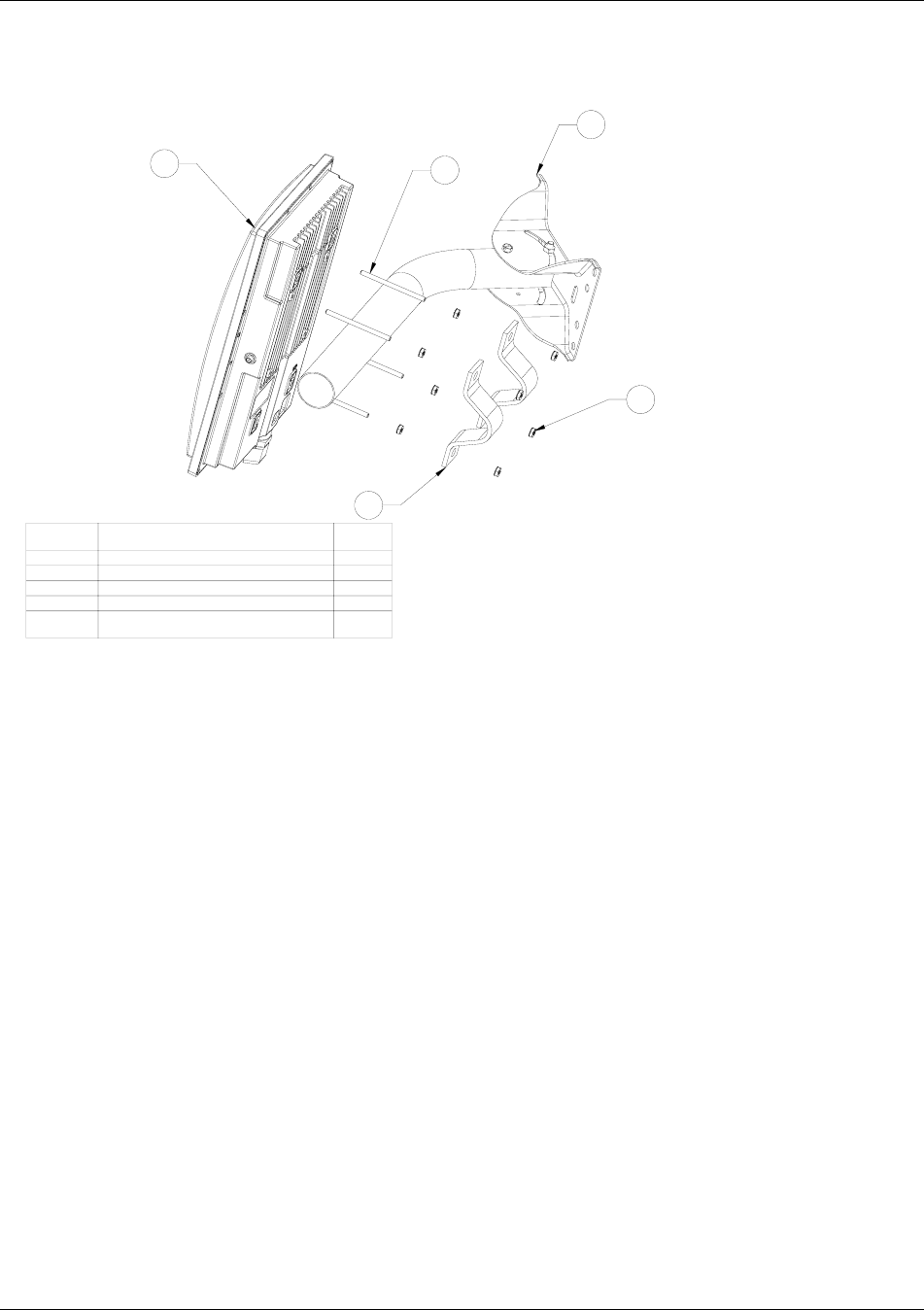
Mounting Hardware
Trango Broadband Wireless — User Manual M915S Rev C Page 28
ITEM
NO. PART NUMBER QTY.
1Radio 1
2 #10 x 3" Threaded Rod 4
3#10 Keps Nut 8
4"V" Bracket 2
5Mono Pod Mount (Not Supplied) 1
Alternate Mounting Configuaration
12
3
4
5Not Supplied
Figure 10: Alternative Mounting
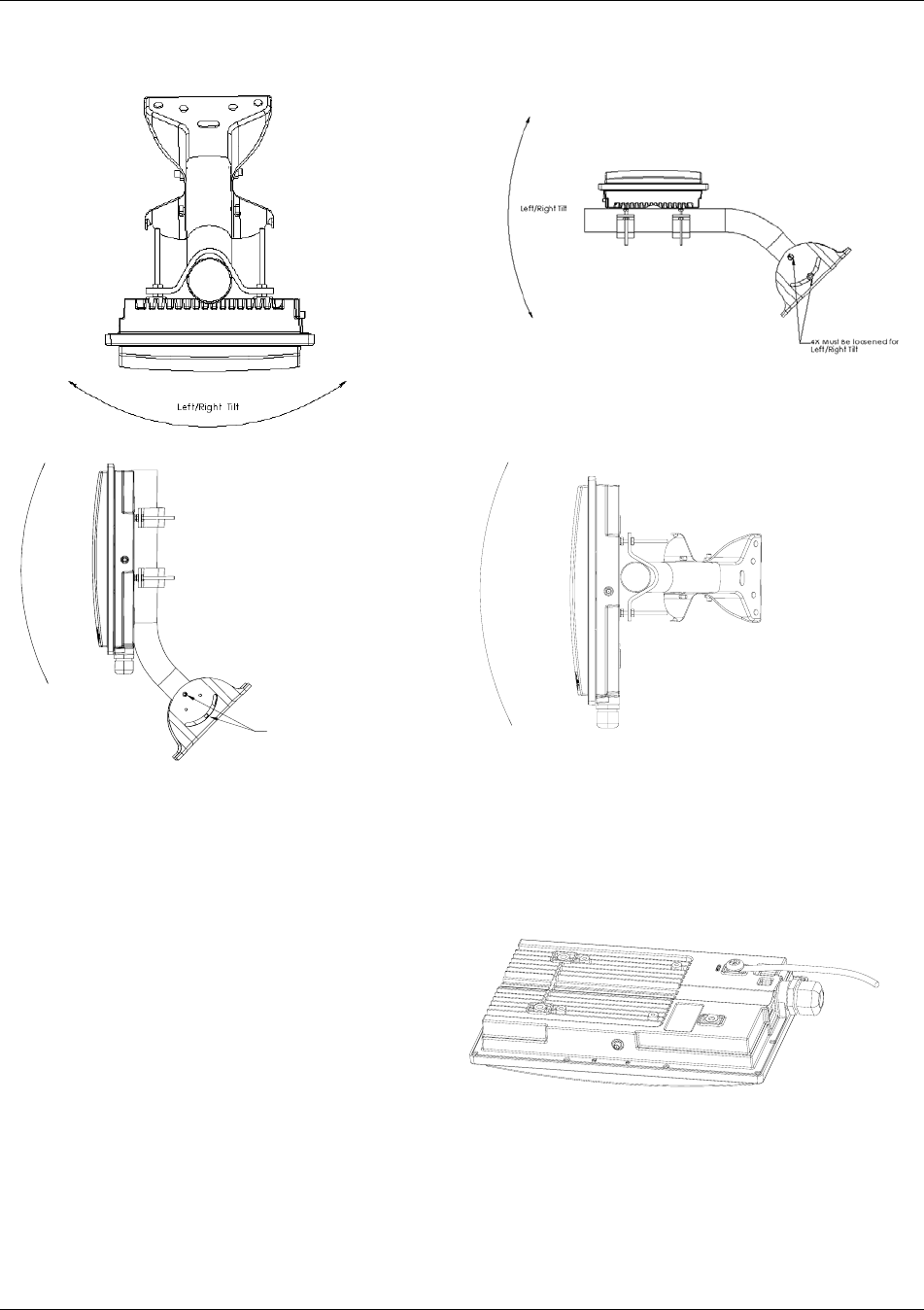
Mounting Hardware
Trango Broadband Wireless — User Manual M915S Rev C Page 29
Standard Mounting Alternative Mounting
Up/Down Tilt
4X M ust B e lo o se n ed fo r
Up/Down Tilt
Up/Down Tilt
Figure 11: Articulation for M915S with Mono Pod Mount (not supplied)
Cabling and Grounding Considerations
Grounding Example
Figure 12: Grounding of the Radio
Proper mounting of the radio includes
considerations for grounding. Please note that
if the radio is attached to a metal pole that is
earth-grounded, no other grounding is
necessary. If the radio is not earth-grounded
via the mounting bracket, you must attach a
grounding wire to the grounding stud on the
back of the radio as in the adjacent diagram.

Mounting Hardware
Trango Broadband Wireless — User Manual M915S Rev C Page 30
Installation Notes
Access to the radio’s RJ-45 Port and LED status lights are purposely located at the bottom of the radio to minimize the risk of
water intrusion. Do not mount the radio upside down.
The J-Box is not a weatherized device, and must be located either indoors or in a weather-protected cabinet.
Shielded twisted pair Cat-5 cable is recommended for all installations unless the cable is placed in metal conduit.
The shield within the Cat-5 cable does not need to be grounded if the radio itself is grounded.
It is important to consider that most Cat-5 cable will deteriorate over time if exposed to the weather (especially direct
sunlight). Conduit (metal or PVC) is recommended to protect the cable. The radio cable entry point uses NPT ¾ pipe
threads to allow conduit fittings to be used.
Important! The Ethernet port compression washer should be loosely tightened around the cat-5 cable to
allow pressure equalization within the radio enclosure. Leave approximately 1 mm around the cat-5.
!
It is important to provide strain relief and a drip loop for STP Cat-5 cables. Do not mount the radio
upside down.

Deployment
Trango Broadband Wireless — User Manual M915S Rev C Page 31
Section 7 Deployment
Once you are familiar with the basic operation of the radios you are ready for deployment in the field. The deployment
process consists of the following steps:
• Site Selection
• Site Survey
• Channel Planning
• SU Antenna Alignment
• Link Management Commands
Site Selection
Proper site selection for your AP will help ensure a successful deployment. Site selection will depend on a wide variety
of factors, but from the radio’s performance standpoint, please consider the following:
• Path from AP to SU should provide as few obstructions as possible, thus it is advisable to place the AP as high as
possible on a tall building or tower.
• Ethernet cable limit is 300 feet from Ethernet device (router, switch) to the radio.
• Radios require grounding for optimal performance.
• AP provides sector coverage of 60º azimuth and 60º elevation.
• Consider nearby sources of interference that could degrade the performance of the radio. Mount radios as far
from sources of interference as possible.
• Perform a site survey to determine noise level and relative clarity of channels at chosen installation location.
Site Survey
Both the AP and SU provide a powerful on-board site survey tool. This tool will tell you if there is interference present in
the 900 MHz ISM band.
Command: survey <time> <antenna>
In order to use the survey command, the radio must be in Opmode “OFF.” The survey can be performed for up to 10
seconds per channel (incrementing by 2 MHz), and for the horizontal polarization, vertical polarization, or an external
antenna.
Prior to performing the site survey, place the radio in the installation spot and aim the radio in the desired direction.
After the specified period, the results of the test will provide you with a listing of each channel in the band, the average
signal received, and the maximum signal received during the survey period.
In general you will be looking for frequencies with interference signal strength of –85 dBm or lower. If interference is
present on various channels, it is recommended that you chose clean channels or alternate polarizations for your
deployment. If it is not possible to use a clean channel/polarization combination, there are various methods available to
mitigate the affects of interference. These methods include the use of the RFRX Threshold settings, or the use of external
shields and external narrower beam antennas.

Deployment
Trango Broadband Wireless — User Manual M915S Rev C Page 32
Example:\
#> survey 2 v
Press [space] then [enter] to stop
880 MHz peak -94 dBm avg -99 dBm
882 MHz peak -94 dBm avg -99 dBm
884 MHz peak -94 dBm avg -99 dBm
886 MHz peak -94 dBm avg -99 dBm
888 MHz peak -94 dBm avg -99 dBm
890 MHz peak -94 dBm avg -98 dBm
892 MHz peak -93 dBm avg -95 dBm
894 MHz peak -92 dBm avg -92 dBm
896 MHz peak -91 dBm avg -91 dBm
898 MHz peak -90 dBm avg -90 dBm
900 MHz peak -91 dBm avg -92 dBm
902 MHz peak -92 dBm avg -93 dBm
904 MHz peak -92 dBm avg -93 dBm
906 MHz Ch 1 peak -92 dBm avg -94 dBm
908 MHz peak -92 dBm avg -94 dBm
910 MHz peak -91 dBm avg -93 dBm
912 MHz Ch 2 peak -92 dBm avg -92 dBm
914 MHz peak -91 dBm avg -92 dBm
916 MHz peak -92 dBm avg -94 dBm
918 MHz Ch 3 peak -92 dBm avg -92 dBm
920 MHz peak -92 dBm avg -93 dBm
922 MHz peak -89 dBm avg -90 dBm
924 MHz Ch 4 peak -89 dBm avg -89 dBm
926 MHz peak -88 dBm avg -90 dBm
928 MHz peak -57 dBm avg -70 dBm ***
930 MHz peak -65 dBm avg -66 dBm ***
932 MHz peak -69 dBm avg -70 dBm ***
934 MHz peak -76 dBm avg -78 dBm *
936 MHz peak -93 dBm avg -94 dBm
938 MHz peak -85 dBm avg -90 dBm
940 MHz peak -83 dBm avg -88 dBm
942 MHz peak -83 dBm avg -89 dBm
944 MHz peak -94 dBm avg -99 dBm
946 MHz peak -94 dBm avg -99 dBm
948 MHz peak -94 dBm avg -99 dBm
950 MHz peak -94 dBm avg -99 dBm
Once the site survey is completed, you are ready to install your radios. It is recommended that APs be installed first. The
reason for this is that the SU has a built-in RSSI tool that will help you properly aim the SU at the AP to achieve
maximum signal strength.
AP Search and SU Antenna Alignment
Once the AP is installed and aligned in the correct general direction, it is time to install the SU. The hardware installation
of the SU is identical to that of the AP, including considerations for line-of-sight, cable distances, cable type, weather
sealing, and grounding.
Once the SU is installed and aimed in the general direction of the AP, it is time to perform an RSSI (relative signal
strength indicator) test to determine the signal strength from the AP, and to precisely align the SU antenna for maximum
signal strength.
Although it is possible to rely upon the SU’s LEDs for alignment, more precise RSSI readings are available from the
command ssrssi.
In this example of a survey
on vertical polarization for 2
seconds on each 2 MHz
portion of the spectrum, the
largest amount of
interference was detected
at frequency 930 MHz (out-
of-band).
The asterisks, ****, indicate
the highest amounts of
interference detected and
correspond to the number
of yellow colored LEDs lit
when opmode is on.
Note that the survey covers
spectrum outside the
operational range of the
radio to allow detection of
paging/cellular services that
may desensitize the
receiver section of the
radio.

Deployment
Trango Broadband Wireless — User Manual M915S Rev C Page 33
In conjunction with the RSSI command, it is also useful to perform the apsearch command that will tell you which AP is
providing an adequate signal at the location of the SU.
AP Search
1. Ensure AP is in Opmode “On.”
2. Run the apsearch command to verify which AP is providing the strongest signal strength.
#> apsearch
Press [space] then [enter] to stop
1 906 Hz 1234 DE 15 5C D0 [H: -32 dBm] [V: -50 dBm] [E: -78 dBm]
2 912 Hz ---- FF FF FF FF [H: -80 dBm] [V: -86 dBm] [E: -99 dBm]
3 918 Hz ---- FF FF FF FF [H: -85 dBm] [V: -86 dBm] [E: -99 dBm]
4 924 Hz ---- FF FF FF FF [H: -82 dBm] [V: -81 dBm] [E: -99 dBm]
RSSI Command for Antenna Alignment
Step 1 Telnet into the SU (while in Opmode “OFF”). Use the freq and antenna command to note the radios current
settings.
Step 2 Run the rssi command. The telnet session screen will begin a continuous readout of the received signal strength.
As you read the RSSI reading, move the antenna in the horizontal and vertical planes until the maximum RSSI reading is
achieved. To allow for plenty of fade margin, we recommend a continuous RSSI reading of -78 dBm or better. An RSSI
of –88 dBm will allow you to establish a wireless link, but there may not be sufficient fade margin for reliable and
continuous operation.
Example 1 has the wrong freq and antenna settings:
#> rssi
[ 1] peak -80 dBm avg -93 dBm
[ 2] peak -80 dBm avg -97 dBm
[ 3] peak -99 dBm avg -99 dBm
Example 2 has the correct freq and antenna settings:
#> rssi
[ 1] peak -33 dBm avg -74 dBm **
[ 2] peak -33 dBm avg -68 dBm ***
[ 3] peak -33 dBm avg -64 dBm ****
Step 3 If it is not possible to receive an adequate RSSI reading, it may be necessary to reorient the AP (up/down,
left/right), to increase the output power of the AP, or to move the SU to a location with better line-of-sight conditions to
the AP. Alternatively consider using external antennas on either the AP or SU or both.
Once you are satisfied with the RSSI reading, tighten down the SU in the optimum position. To stop the RSSI continuous
readout, hit SPACE ENTER.
SU Alignment Using LEDs
The LED RSSI indicators on the bottom of the radio provide a handy alignment tool. If all four LEDs are lit, the unit is
receiving –60 dBm or stronger. If no LEDs are lit, there is not sufficient signal strength to establish a wireless link.
Lit LEDs Signal Strength
0 LED -80 dBm
1 LED -75 dBm
2 LED -70 dBm
In this example, an AP is detected on channel 1,
polarization horizontal. Further, the Base ID is 1234, and
the MAC address is 00 01 DE 15 5C D0.
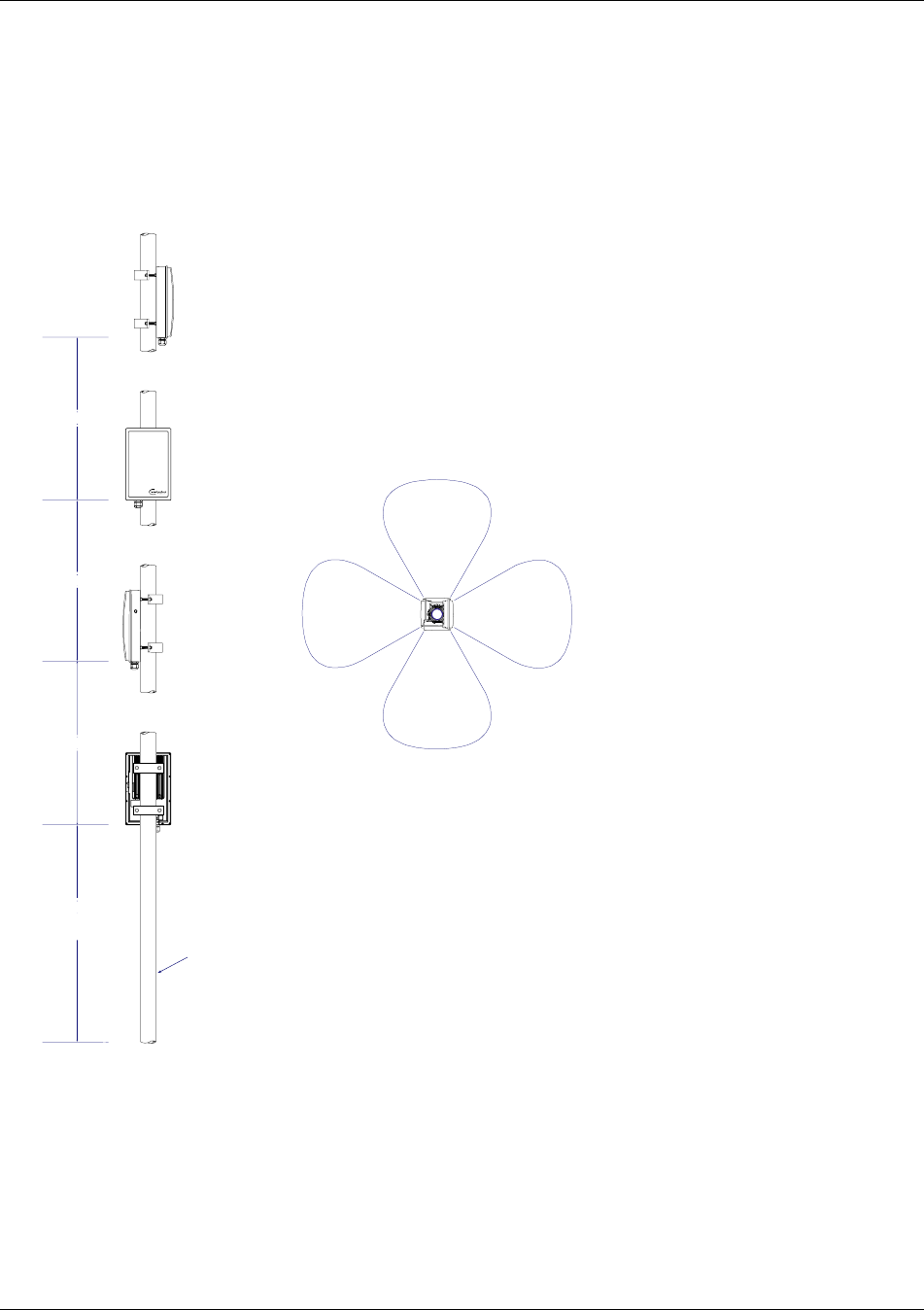
Deployment
Trango Broadband Wireless — User Manual M915S Rev C Page 34
3 LED -65 dBm
4 LED -60 dBm
Collocation and Channel Planning
With proper channel planning and adherence to installation guidelines, multiple M915S APs may co-exist and operate
interference-free on the same tower or building. The main consideration when collocating APs is to ensure at least 10 ft.
of vertical separation. See the diagram below for collocation spacing, and a suggested channel plan.
10 ft
10 ft
10 ft
CH 3
CH 1
CH 4
CH 2
Mounting Mast
30 ft
above
trees/structures
60°
60°
60°60°
CH 3
CH 1
CH 4
CH 2
ADJUSTMENTS IN AZIMUTH
WILL NO
T
HAVE A GREAT EFFECT
ON COLOCATION INTERFERENCE
M915S
COLOCATION SPACING
Link Management Commands
Once the radios are properly aligned for maximum RSSI, ensure the SU’s default Opmode is “ON” and that all
configuration parameters are correct.
Reboot the SU. Once the SU enters Opmode “ON,” the authentication process will begin, and the two radios will begin to
associate. From the AP side there are several basic diagnostics commands, such as su ping, su status, and su testrflink,
to ensure that a reliable RF link has been established. It may take one minute or more for the association process to
complete. This process may take longer if there are many SUs in the sector.

Deployment
Trango Broadband Wireless — User Manual M915S Rev C Page 35
In establishing and diagnosing the quality of the link between the AP and SU(s), there are a few commands that are
especially useful. All of these commands are performed at the AP. A summary of these commands follows:
su
Displays the status of all SUs in the AP’s SUDB. SUs in the SUDB will appear by SU ID, and are classified into one of
the following status categories: Associated, Associating, and OFF.
Example:
#> su
[Priority] 88
[0]
[1]
[2]
[3] 88
[4]
[5]
[Associating]
[Power Off]
Success.
Note: In this, and the following, examples the SU ID is 88
su ping <su#>
AP will send 10 RF pings to the designated SU ID. The response from each ping will indicate latency (in micro-seconds)
and the strength (RSSI) of the signal received back from the SU for each of the 10 pings. Note this command will also
tell you the distance from the AP to the SU.
Example:
#> su ping 88
[#Begin]
[001]
Ping #0 -> -57 dB 374 us 0.0 mi
Ping #1 -> -57 dB 373 us 0.0 mi
Ping #2 -> -57 dB 373 us 0.0 mi
Ping #3 -> -56 dB 373 us 0.0 mi
Ping #4 -> -56 dB 373 us 0.0 mi
Ping #5 -> -56 dB 374 us 0.0 mi
Ping #6 -> -57 dB 373 us 0.0 mi
Ping #7 -> -57 dB 374 us 0.0 mi
Ping #8 -> -56 dB 374 us 0.0 mi
Ping #9 -> -56 dB 373 us 0.0 mi
[#End]
Avg = -56 dB
Success.
su <su #>
AP will poll the SU for SU’s current status and will provide information such as SU range from AP, signal strength
received at SU from AP, SU temperature, etc. .
Example:
> su 88
[ 88] pr [as] y [d] 0.0 [rssi at ap] -60 dBm [rssi at su] -33 dBm

Deployment
Trango Broadband Wireless — User Manual M915S Rev C Page 36
[ip] 192.168.100.120 [subnet] 255.255.255.0 [gateway] 192.168.100.120
[mac] 00 01 DE 16 E3 7F
[hw ver] 0005 [fpga ver] 03121104 [fpga chksum] 75930BDC
[fw ver] 1p0a2 [fw chksum] F4658C90 [fw datecode] 04010603
[default channel and antenna] 3 h [active channel and antenna] 3 h
[tx power] 26 dBm
[ch#1] 906 [ch#2] 912 [ch#3] 918 [ch#4] 924
[remarks]
[RF Tx Retry at AP] 0 [RF Tx Retry Maxed Out at AP] 0
[RF Tx Retry at SU] 0 [RF Tx Retry Maxed Out at SU] 0
Success.
su linktest <su#>
This command checks the integrity of the wireless link from the standpoint of performance (throughput) and over-the-air
packet loss. The AP will send 100 (1600 byte) packets to the SU, and the SU will return the packets it receives to the AP.
A perfect link (without dropped packets) will yield average throughput of 3,000 kbps. If heavy packet loss occurs, it may
be caused by interference or multi-path.
Example:
#> su linktest 88
[suid] 88 [pkt len] 1600 bytes [# of pkts per cycle] 100 [cycle] 10
0 [AP Tx] 100 [AP Rx] 100 [AP RxErr] 0 [SU Tx] 100 [SU Rx] 100 [SU RxErr] 0 866 ms 2956 kbps
1 [AP Tx] 100 [AP Rx] 100 [AP RxErr] 0 [SU Tx] 100 [SU Rx] 100 [SU RxErr] 0 866 ms 2956 kbps
2 [AP Tx] 100 [AP Rx] 100 [AP RxErr] 0 [SU Tx] 100 [SU Rx] 100 [SU RxErr] 0 866 ms 2956 kbps
3 [AP Tx] 100 [AP Rx] 100 [AP RxErr] 0 [SU Tx] 100 [SU Rx] 100 [SU RxErr] 0 866 ms 2956 kbps
4 [AP Tx] 100 [AP Rx] 100 [AP RxErr] 0 [SU Tx] 100 [SU Rx] 100 [SU RxErr] 0 866 ms 2956 kbps
5 [AP Tx] 100 [AP Rx] 100 [AP RxErr] 0 [SU Tx] 100 [SU Rx] 100 [SU RxErr] 0 866 ms 2956 kbps
6 [AP Tx] 100 [AP Rx] 100 [AP RxErr] 0 [SU Tx] 100 [SU Rx] 100 [SU RxErr] 0 866 ms 2956 kbps
7 [AP Tx] 100 [AP Rx] 100 [AP RxErr] 0 [SU Tx] 100 [SU Rx] 100 [SU RxErr] 0 866 ms 2956 kbps
8 [AP Tx] 100 [AP Rx] 100 [AP RxErr] 0 [SU Tx] 100 [SU Rx] 100 [SU RxErr] 0 866 ms 2956 kbps
9 [AP Tx] 100 [AP Rx] 100 [AP RxErr] 0 [SU Tx] 100 [SU Rx] 100 [SU RxErr] 0 866 ms 2956 kbps
[AP Total nTx] 1000 pkts
[AP Total nRx] 1000 pkts
[AP Total nRxErr] 0 pkts
[SU Total nTx] 1000 pkts
[SU Total nRx] 1000 pkts
[SU Total nRxErr] 0 pkts
[AP to SU Error Rate] 0.00 %
[SU to AP Error Rate] 0.00 %
[Avg of Throughput] 2956 kbps
#> Success.
su testrflink <su#>
This command also checks the integrity of the wireless link from the standpoint of over-the-air packet loss. Relative to the
linktest command, however this test does not provide as much detail. In this test the AP will send 20 large (1512 byte)
packets to the SU, and the SU will in turn send the same 20 packets back to the AP. The expected result of an error free
link is 20..20..20, indicating (in the following sequence) 20 packets sent from the AP, 20 packets received back at the AP,
and 20 packets received at the SU. Any results other than 20..20..20 indicate a performance problem, and are most likely
due to interference or an inadequate signal to noise ratio. For thorough results, it is recommended that you run the
command repeatedly for at least 1 minute or more to determine if packets are passing without error consistently over time.

Management
Trango Broadband Wireless — User Manual M915S Rev C Page 37
The “r” is used in this command to repeat the RF link test repeatedly until the user terminates the test by hitting SPACE
ENTER.
Example:
#> su testrflink 88 r
Press [space] then [enter] to stop
[len] 1512
[suid] 88
[ 0] ...........[AP Tx] 20 [AP Rx] 20 [SU Rx] 20
[ 1] ...........[AP Tx] 20 [AP Rx] 20 [SU Rx] 20
[ 2] ...........[AP Tx] 20 [AP Rx] 20 [SU Rx] 20
[ 3] ...........[AP Tx] 20 [AP Rx] 20 [SU Rx] 20
[ 4] ...........[AP Tx] 20 [AP Rx] 20 [SU Rx] 20
[ 5] ...........[AP Tx] 20 [AP Rx] 20 [SU Rx] 20
Success.
As another example, a result of 20..10..18 would indicate 20 packets sent from the AP, 18 packets received at the SU, and
10 packets received back at the AP. You might expect this type of results from Fresnel zone infringements, interference,
or multi-pathing.
ARQ with Selected Repeat and Multirate Feature
The M915S features ARQ or “Automatic Request for Re-transmission,” which provides the ability to correct for missing
or corrupted packets of data by asking the sender to re-transmit the data.
Both the AP and SU units implement a form of ARQ known as “ARQ with Selected Repeat.”
The units makes a first attempt at transmitting a data frame using the 3.250 Mbps rate. Then, if a re-try is required, the
2nd attempt will also be at 3.250 Mbps. The 3rd and 4th attempts will be at a rate of 1.625 Mbps. After the 4th attempt
there will be no more re-tries and a counter describing “maximum retries reached” will be incremented.
• A minimum of 100ms is placed between re-transmission requests.
• The units buffer up to 600 frames, or 4 seconds worth, of RF TX Data frames to support the ARQ algorithm.
• The AP unit maintains counters concerning the ARQ algorithm on a per SU basis. The counters include the
following data:
Total Transmitted Frames
Total Retransmission Attempts
Total “Maximum Attempts Reached”
The SU unit maintains counters concerning its use of the ARQ algorithm. The counters include the same data as in the
AP.

Management
Trango Broadband Wireless — User Manual M915S Rev C Page 38
Section 8 Management
Section Topics:
• Radio Management Access using TCP/IP
• SU Management from the AP’s command set
• SNMP
Radio Management Access Via TCP/IP
The IP Address of an M915S radio is for management purposes only. The IP address is not used for purposes of routing
or passing traffic. Users should take care to set appropriate IP schemes for all management activities including upgrading
the radio’s firmware. It is not uncommon for users to assign public IP addresses to the radios so that they can be accessed
from anywhere via the Internet. In order to gain TCP/IP access to SU (from either side of the wireless network), ensure
that SU Switches 2 and 6 are turned on. In order to gain TCP/IP access to the AP from the SU side of the wireless
network, ensure that AP Switch 7 is turned on.
SU Management from AP
The AP provides functionality and several commands that permit the management of associated SUs. In fact, most
system management functions are performed by issuing commands from the AP. Presented below are a few examples of
these commands:
su ping <suid>
su status <suid>
su ipconfig <suid> <new IP> <new subnet> <new gateway>
su password <suid | all> <rw | ro> <new password> <new password>
su reboot <all|suid>
su testrflink <all|suid> [<r>]
su sw <suid> <sw #> <on|off>
Note: SU commands issued from the AP will automatically update the SU’s flash memory. No save ss command is
necessary.
As an example, you can remotely change the password for a single SU or all SUs in a sector:
su password <suid | all> <rw | ro> <new password> <new password>
Example:
#>su password all rw hello hello
to remotely change the read write password on all SUs to “hello”
As another example, to change an SU’s IP, subnet, and gateway: su ipconfig <suid> <new ip> <new subnet> <new
gateway>
Type the following:
#>su ipconfig 7 192.168.10.10 255.255.255.0 192.168.10.1
In this example SU #7’s IP address was changed to 192.168.10.10, the subnet mask to 255.255.255.0, and the gateway to
192.168.10.1.
A complete description of these commands and many others can be found in Appendix A – Command Set Reference.

Management
Trango Broadband Wireless — User Manual M915S Rev C Page 39
Loading Multiple SUs into the SUDB using DLOAD Command
To load a full database of SU entries into the AP’s SUDB, you need to create a subscriber database in ASCII text file
format. As shown below, each row represents all information for one SU. Each column is an information field, which
includes: SU ID, SU to SU group, service level, CIR, MIR, and MAC address.
005 re a B 3000 3000 3000 3000 0000 00 01 de 16 e3 60
007 re a B 3000 3000 3000 3000 0000 00 01 de 16 e3 7c
009 re a B 3000 3000 3000 3000 0000 00 01 de 16 e3 7b
000 --- End of file indicator
--- -- - - ---- ---- ---- ---- ---- -----------------
| | | | | | | | | |
| | | | | | | | | |
| | | | | | | | | ------------- MAC Address
| | | | | | | | |
| | | | | | | | |
| | | | | | | | ----------------------- Reserved (should be 0000)
| | | | | | | |
| | | | | | | |
| | | | | | | ---------------------------- MIR Uplink
| | | | | | |
| | | | | | |
| | | | | | --------------------------------- MIR Downlink
| | | | | |
| | | | | |
| | | | | -------------------------------------- CIR Uplink
| | | | |
| | | | |
| | | | ------------------------------------------ CIR Downlink
| | | |
| | | |
| | | --------------------------------------------- SU2SU Group ID
| | |
| | |
| | ------------------------------------------------ Rate (currently not supported,
| | value should be a)
| |
| --------------------------------------------------- pr Priority User
| re Regular User
|
|
------------------------------------------------------ SU ID (1..127)
1. Telnet into the AP and run the command tftpd on to enable TFTP process.
2. Tftp the file to the AP from your DOS prompt example: tftp <IP of AP> put mySUs.txt.
3. From the AP’s telnet session, run the command sudb dload to load and activate the SUDB.
4. Run the command sudb view to verify the SUDB entries.
Run command save sudb to write the SUDB to non-volatile memory.
SNMP
The M915S supports Simple Network Management Protocol (SNMP) for network management. Network management
consists of the following 4 categories: configuration, accounting, alarm, and monitoring and control. These capabilities
allow the network operator to provide superior services through higher network availability and integrated accounting
systems. For more information on SNMP and its uses, you can visit http://www.faqs.org/faqs/snmp-faq/.

Management
Trango Broadband Wireless — User Manual M915S Rev C Page 40
The Trango SNMP solution supports MIB-II (system only) and the Trango proprietary Management Information Base
(MIB). The SNMP agent resides on the AP ONLY. The AP gathers health, status, and performance statistics from all
SUs locally, then responds back to the SNMP manager upon request.
Users interested in using the SNMP functionality should review the entire M915S MIB for a complete understanding of
its features. The M915S MIB is available for download at:
http://www.trangobroadband.com/support/downloads.htm
The following is an overview of a few of the more commonly used SNMP objects in the M915S system.
Objects for Monitoring and Control
SU Bandwidth Monitoring
• suEthRXAvgThroughputLog – Average payload data throughput (in Kbits/sec) received on the Ethernet port
over the period specified by suStatisticsSamplePeriod (1 ~ 60 minutes).
• suEthTXAvgThroughputLog - Average payload data throughput (in Kbits/sec) transmitted from the Ethernet
port over the period specified by suStatisticsSamplePeriod (1 ~ 60 minutes).
• suRFRXAvgThroughputLog - Average payload data throughput (in Kbits/sec) received over the RF link over
the period specified by suStatisticsSamplePeriod (1 ~ 60 minutes).
• suRFTXAvgThroughputLog - Average payload data throughput (in Kbits/sec) transmitted over the RF link
over the period specified by suStatisticsSamplePeriod (1 ~ 60 minutes).
• suRFInOctets – Number of octets of payload transmitted from the AP’s RF port.
• suRFOutOctets – Number of octets of payload received on the AP’s RF port.
AP Bandwidth Monitoring
• aptrafficEthRXAvgThroughputLog – Average payload data throughput (in Kbits/sec) received on the Ethernet
port over the period of 1 minute.
• aptrafficEthTXAvgThroughputLog – Average payload data throughput (in Kbits/sec) transmitted from the
Ethernet port over a period of 1 minute.
• aptrafficRFRXAvgThroughputLog – Average payload data throughput (in Kbits/sec) received over the RF
link for a period of 1 minute.
• aptrafficRFTXAvgThroughputLog – Average payload data throughput (in Kbits/sec) transmitted over the RF
link for the period of 1 minute.
• aptrafficEthInOctets – Number of octets of payload received on the Ethernet port.
• aptrafficEthOutOctets – Number of octets of payload transmitted from the Ethernet port.
• aptrafficRFInOctets – Number of octets of payload received on the RF port.
• aptrafficRFOutOctets – Number of octets of payload transmitted from the RF port.
Link Status Monitoring –Various traps are defined as follows:
• Cold start – when SNMP agent starts running
• Link Up – when the AP enters Opmode “ON”
• Link Down – when the AP reboots
• SU Link Up – when SU associates to the AP
• SU Link Down – when SU disassociates from the AP
• “AP” Opmode Failure – when AP fails to enter Opmode “ON”
AP and SU Control – SNMP also provides several control capabilities. The majority of the features available on the CLI
are also available via SNMP. Here are a few of these features:
• Add/delete subscriber
• Change channel
• Set power
• Set radio sensitivity
Review the Trango M915S MIB for the complete listing of MIB Objects.

Management
Trango Broadband Wireless — User Manual M915S Rev C Page 41
SNMP Setup
Trango Broadband provides only the MIB portion of the SNMP Management system. The radios act as individual agents,
and it is up the user to provide an SNMP Manager software from a third party vendor. Below is an example of the setup
process for SNMPc from Castle Rock™.
1. Unzip trangopkg.zip file to a local temporary directory.
2. Go to your local temporary directory, you will see 4 files shown below.
a. trango_M915Sap_1p0.mib – M915S AP MIB file
b. trango.ico – M915S AP icon
c. autoico.txt – instruction file (Selects Trango icon automatically during initial set-up.)
d. Readme.pdf – Configuration Guide
3. Copy trango_M915Sap_1p0.mib file to C:\Program Files\SNMPc Network Manager\mibfiles
4. Copy autoico.txt file to C:\Program Files\SNMPc Network Manager\mibfiles
5. Copy trango.ico file to C:\Program Files\SNMPc Network Manager\bitmaps
6. The MIB needs to be compiled into the SNMPc database
By default, the Read Community is set to “public”, and Write Community is set to “private,” in the AP. The Trap
Community is “SNMP_trap.” The manager needs to have the same settings in order to communicate with the AP
successfully.
To send traps from the AP, set the following:
• trap destination IP (Trango MIB object trapconfig–trapconfigInfo)
• trap community string (Trango MIB object trapconfig–aptrpTable-AptrpEntry)
• enable each trap (Trango MIB object traponfig–aptrpTable-AptrpEntry)
For all the set operations, set object SaveAndActivate at apsystem-apsystemInfo to write the information to FLASH.

Trango Broadband Wireless — User Manual M915S Rev. A Page 42
Appendix A Command Set Reference
(ro = read only access, rw = read write access)
Command Radio Description Access
? AP/SU
Display complete list of commands and syntax ro/rw
? <command> AP/SU Display specific command syntax ro/rw
antenna AP/SU Display current antenna setting
(h=horizontal, v=vertical, e=external )
ro/rw
antenna <e | h | v> AP/SU Select antenna mode
(h=horizontal, v=vertical, e=external)
rw
aprssi <ch#> <antenna, h | v | e> AP/SU Scan two strongest APs
(Opmode “OFF” only)
ro/rw
apsearch AP/SU Scan all channels to look for APs
(Opmode “OFF” only)
ro/rw
arq AP/SU Display current ARQ settings ro/rw
arq <on|off> AP/SU Enable/disable ARQ rw
bye AP/SU Same as “logout” ro/rw
eth link AP/SU Display current Ethernet setting ro/rw
eth link <100fdx|100hdx|10fdx|10hdx|aneg> AP/SU Change Ethernet duplex setting rw
exit AP/SU Same as “logout” ro/rw
freq AP/SU Display current channel ro/rw
freq <ch#> AP/SU Change current channel rw
freq channeltable AP/SU Display channel table ro/rw
freq writechannel [<ch #> <freq>]… AP/SU Modify center frequency of channel.
<ch #> = 1..4
<freq> = 906..924
Note: This command automatically writes to flash memory.
rw
help AP/SU Display complete list of commands and syntax ro/rw
help <command> AP/SU Display specific command syntax ro/rw
ipconfig [<new ip> <new subnet mask> <new
gateway>]
AP/SU Assign radio’s IP, subnet mask, and gateway IP rw
linktest <txrx|rxtx> [<pkt len, bytes> [<# of
pkts> [<# of cycle>]]]
AP/SU Loopback test to check quality of the wireless link. Variable
parameters include:
pktlen = 64..1760,
# 0 pkts = 1..500
# of cycles = 1..100000
ro/rw
logout AP/SU Log out of radio ro/rw
maclist AP/SU Display current MAC table (MAC addresses of attached devices) ro/rw
maclist reset AP/SU Display or reset current MAC table ro/rw
mirth AP Display MIR (Maximum Information Rate) Threshold ro/rw
mirth <0..3, Mbps> AP Assign MIR Threshold
default = 3 Mbps
mirth 0 = Always On
mirth 3 = Disable MIR Threshold
rw
opmode AP/SU Display current Opmode ro/rw
opmode on [<y>] AP/SU Set Opmode to be “ON” and use “y” if Opmode is not as same as
default Opmode
ro/rw
password <rw|ro> <new pwd> <new pwd> AP/SU Specify new password (max 15 octs)
rw=read/write password, ro=read only password
rw
ping <ip address> AP/SU Ping local Ethernet device
Note: This command only works for local Ethernet devices, not SU
or any device behind SU.
ro/rw
power AP/SU Display current TX power level
default = max. power value
ro/rw
power set <min|max|<dBm> AP/SU Specify TX power for both band
Note: SU’s power will be adjusted by AP during association process
(power leveling)
rw

Trango Broadband Wireless — User Manual M915S Rev. A Page 43
Command Radio Description Access
pppoeonly SU Display current PPPoE filter setting ro/rw
pppoeonly <on | off> SU Change PPPoE filter setting
With PPPoE filter set to ON, only PPPoE packets will pass Default:
off – Pass All Packets
rw
reboot AP/SU Reboot unit ro/rw
remarks AP/SU Display remarks ro/rw
remarks <str,31 octs> AP/SU Overwrite remarks rw
reset AP/SU Reset radio’s system settings back to factory defaults, then reboot rw
rfrxth AP/SU Display current RF RX Threshold ro/rw
rfrxth <-98..-55> AP/SU Change current RF RX Threshold
default = -98 dBm
rw
rssi AP/SU Display current RX RSSI
Opmode “OFF” only on AP
ro/rw
save <mainimage | fpgaimage> <current
chscksum> <new checksum>
AP/SU Save new firmware. This command gets new firmware image from
TFTP buffer, verifies checksum and writes to flash memory at main
or FPGA image section.
rw
save sudb AP Save SUDB into flash memory rw
save <systemsetting | ss> AP/SU Save current configuration into flash memory rw
set apid <ap-id> AP Set AP ID, <ap-id> = 1..255 rw
set baseid <base-id, 4 oct> AP/SU Set base station id Base ID = XXXX where X = any alphanumeric
character except “/”
rw
set defaultopmode <on | off> AP/SU Set default Opmode to “ON” or “OFF”
Factory set default Opmode is “OFF”
rw
set httpport [<port #>] AP/SU Set or display HTTPD port number
port # = 1..65534
default port = 80
rw
set snmpcomm <read | write | trap id# |trap all> AP/SU Set SNMP read or write or trap community string rw
set telnetport [<port #>] AP/SU Specify telnet port, <port #> = 1..65534
Default port = 23
rw
snmpsample <min, 1..60> AP/SU Set SNMP sample period rw
su password <suid | all> <rw | ro> <new
password> <new password>
AP Change read/write or read-only password of all or a specific
subscriber
rw
su <all | suid> AP Display all or specific SU information in SUBD ro/rw
su info <suid> AP Command issued from the AP to gather information about specific
SUs.
1. Distance
2. RSSI at AP
3. RSSI at SU
4. IP address
5. Subnet address
6. Gateway address
7. Device ID
8. Hardware version
9. FPGA version
10. FPGA checksum
11. Firmware version
12. Firmware checksum
13. Firmware datecode
14. Broadcast/multicast packet filter on/off
15. Auto scan AP on/off
16. TCP/IP for AP on/off
17. HTTPD on/off
18. TCP/IP service for Ethernet port on/off
19. Default channel and antenna
20. Active channel and antenna
21. TX power
ro/rw

Trango Broadband Wireless — User Manual M915S Rev. A Page 44
Command Radio Description Access
22. Remarks
23. RF TX retry at AP, RF TX retry maxed out at AP
RF TX retry at SU, RF TX retry maxed out at SU
su ipconfig <suid> <new IP> <new
subnet> <new gateway>
AP Change IP, subnet, gateway for specified SU rw
su linktest <suid> AP Perform linktest for specified SU ro/rw
su ping <suid> AP Request SU’s ranging and RSSI information ro/rw
su reboot <all | suid> AP Reboot a specific SU or all SUs rw
su sw <suid> <sw #> <on | off> AP Change switch settings on specified SU rw
sudb add <suid> <pr|re> <mac> AP Add new SU to SUDB rw
sudb cirmir <<suid>|all> <cir dn> <cir up>
<mir dn> <mir up>
AP Change SU’s CIR/MIR settings rw
sudb defaultcirmir AP Display default CIR and MIR in SUDB ro/rw
sudb defaultcirmir <cir_dn, 0..3000> <cir_up,
0..3000> <mir_dn, 0..3000> <mir_up, 0..3000>
AP Change default CIR and MIR rw
sudb defaultcirmir <default cir dn> <default cir
up> <default mir dn> <default mir up>
AP Set MIR/CIR values to default values rw
sudb delete <suid | all> AP Delete SU in SUDB rw
sudb dload AP Download SUDB file from TFTP buffer and write to flash memory.
This command is used to load a text file that contains the SUDB into
the AP. This command can be useful if there are large numbers of
SUs in the sector.
rw
sudb gid <suid | all> <0..15> AP Change SU’s gid rw
sudb view AP Display all SUDB ro/rw
survey <search time, sec> <antenna, h | v | e> AP/SU Spectrum analysis of the entire band (and near band)
<search time> = 1..10 sec per channel
Opmode “OFF” only
ro/rw
Sw AP/SU Display current sw setting ro/rw
sw 0 [<on | off>] AP/SU set sw #0 – enable or disable packet filter for broadcast/ multicast
packets
on = filtering
default = on
rw
sw 1 [<on | off>] SU Enable or disable SU’s autoscan AP feature
If on, SU will automatically scan each channel and antenna port
searching for AP.
default=on
rw
sw 2 [<on | off>] SU Enable or disable SU’s TCP/IP service for AP
Allows TCP/IP access to SU from AP side of network via wireless
link.
default = on
rw
sw 3 [<on | off>] AP Enable or disable SU to SU (peer to peer) service
default = off
rw
sw 5 [<on | off>] AP/SU Enable or disable HTTPD (browser interface)
default = on
rw
sw 6 [<on | off>] SU Enable or disable TCP/IP service for Ethernet port while SU is in
Opmode “ON”
default = on
rw
sw 7 [<on | off>] AP Enable or disable TCP/IP service for SU. Allows TCP/IP access to
AP from SU side of network via wireless link.
default = on
rw
sysinfo AP/SU Display system configuration ro/rw
targetap SU Display the SU current setting for target AP ro/rw
targetap all SU SU will associate with any AP with the same Base ID
“all” is the default setting.
rw
targetap only <mac1, hex> [<mac2, hex>] SU SU will only associate with AP with specified MAC addresses. rw
targetrssi AP Display SU Target RSSI in dBm. This setting is used in the SU
power leveling process.
ro/rw
targetrssi <dBm, -90..-50> AP Change target RSSI. Note: Target RSSI must be +5 dB more than
rfrxth (RFRX Threshold).
rw

Trango Broadband Wireless — User Manual M915S Rev. A Page 45
Command Radio Description Access
default = -60
tftpd AP/SU display current TFTPD status (status is either on or off) This
command will also list any contents of the TFTP buffer.
ro/rw
tftpd <on | off> AP/SU enable or disable TFTPD service. TFTPD must be on in order to
upload new firmware or new SUDB file.
rw
updateflash <systemsetting | ss> AP/SU Save current settings. This command can be issued in several ways:
save ss, updateflash systemsetting, save systemsetting, and
updateflash ss
rw
updateflash <mainimage | fpgaimage>
<current chscksum> <new checksum>
AP/SU Retrieve uploaded firmware from TFTP buffer, verify checksum,
and write to flash memory at main or FPGA image section.
rw
updateflash sudb AP Save SUDB into flash memory rw
ver AP/SU Display firmware and date codes
1. Version number and date code
2. Firmware and FPGA version code
3. Firmware and FPGA image checksum
ro/rw

Trango Broadband Wireless — User Manual M915S Rev. A Page 46
Appendix B Specifications
All specifications apply to the M915S-AP and M915S-SU, unless otherwise noted.
Radio Transmit Specifications
Storable Channels: 4 memory locations
Agility: 906 to 924 MHz in 1 MHz increments
Default channels:
Channel 1: 906 MHz
Channel 2: 912 MHz
Channel 3: 918 MHz
Channel 4: 924 MHz
Power Control Range: Max: +26 dBm +/- 1
Min: -4 dBm +/- 2
Step: 1 dB
Pout: +26 dBm max
Ant. Gain: 10 dBi typical
EIRP: +36 dBm typical (4 Watts)
Freq. Stability: +/- 1.5 ppm PLL stabilized (+/-2.5ppm) over temperature
Freq. Plan: Single upconversion, 140 MHz IF
Modulated BW: 6.5 MHz (null to null, 40 dB down)
2nd Harmonic atten: Per CFR47 part 15.407
LO Supression: Per CFR47 part 15.407
Receiver Specifications
Storable Channels: 4 memory locations
Agility: 906 to 924 MHz in 1 MHz increments
Default channels:
Channel 1: 906 MHz
Channel 2: 912 MHz
Channel 3: 918 MHz
Channel 4: 924 MHz
Cascade Noise Figure: < 7 dB
Receiver Sensitivity:
3.250 MBPS Rate: - 90 dBm typical-1600 byte packet
(1x10-6 BER) - 90 dBm typical-64 byte packet
1.625 MBPS Rate: - 91 dBm typical-1600 byte packet
(1x10-6 BER) - 91 dBm typical-64 byte packet
Image Rejection: > 90 dB
Frequency Plan: Single conversion, IF at 140 MHz
LO stability: +/- 1.5 ppm PLL stabilized (+/-2.5ppm) over temperature
Ethernet I/O Specifications
Data Input/Output:
Connector: Shielded RJ-45 Jack
Signaling Format: IEEE802.3i (10baseT) and IEEE802.3u (100baseT) compliant

Trango Broadband Wireless — User Manual M915S Rev. A Page 47
Auto-Negotiation: Fully supports IEEE802.3-2002 Sect. 2 Clause 28
Bridging Frame Size: 60 to 1600 bytes
Mgmt Frames: 60 to 1472 bytes (includes PING, TELNET, TFTP, HTTP)
Protection: Bi-directional transient voltage protection diodes on all data lines
compliance with:
IEC61000-4-2 (ESD)
IEC61000-4-4 (EFT)
IEC61000-4-5 (Lightning)
Power Specifications
Input Voltage: Input voltage range at unit is 10.5 VDC to 24 VDC max
Power is supplied via the unused pins of the RJ-45 Jack. Power is injected into the Ethernet cable using a junction box
(provided).
Current Cons.: 400 mA in transmit and receive modes at max power using 24 V
standard adapter (8 W) and 10 ft cable from J-BOX to unit
Protection: 28 volt Transient Voltage Suppression (TVS) on power input
Note: Voltages above 28 volts will cause damage to unit.
Mechanical and Environmental Specifications
General
Material: High Temp Polycarbonate radome and diecast metal enclosure (AP_
High temp ABS enclsure (-SU)
Size: 12.5” x 8” x 2.75” including mounting studs
Weight: <4 lb
Mounting: 2 U-Brackets, all-thread rod, nuts and washers (-AP)
Articulating pole mount (-SU)
Connectors/Indicators
RF Output: Integral internal patch antenna per Part 15C, 15.203
External RP-SMA-f connector for external antenna
FCC Compliance: The transceiver shall comply with the following:
FCC part 15.247
FCC Part 15.207(a)
Operating Temp: -40º to 60º C
Storage: -40º to 85º C
Humidity: 100 % (When sealed properly.)
NEMA Rating: NEMA 4
Shock: Sustain 3 axis drop from 5 feet
Standard External Power Supply
24 Volt DC Power adapter and J-Box supplied with product.
Type: Linear wallmount transformer
Input: 120 VAC
Output: 24 VDC +/- 1 V
Max current: 1000 mA
Connector: 5mm DC Barrel-type Plug
Standard External Power-over-Ethernet Junction Box
Type: In-line female-to-female RJ-45 adapter for CAT-5 Ethernet cable
Connectors:

Trango Broadband Wireless — User Manual M915S Rev. A Page 48
Eth. In: Shielded RJ-45 Jack
DC Input: 5mm DC Barrel-type Jack
Eth. Out & DC Out: Shielded RJ-45 Jack
Pinout for Eth. Out: Power (+) on pins 7+8, ground (-) on pins 4+5 and eth. data on pins 1,2,3 & 6
Indicators: 2 LEDs to indicate power and a connection to radio
Protection: Resettable fuse for DC input
Integrated Antenna (M915S-SU and M915S-SU-EXT)
Type: Dielectric-loaded Patch Antenna
Polarization: Vertical or Horizontal Polarization, electrically selectable
Frequency: 902 to 928 MHz
Gain: +9 dBiL +/- 1 dB
Az Beamwidth: 60º (3 dB pts)
El Beamwidth: 60º (3 dB pts)
Cross Pol: >15 dB
Front/Back Ratio: 15 dB
VSWR: < 2.0:1 over Bandwidth